UBS Axcera 836A 2000-Watt UHF Translator User Manual 836
UBS-Axcera 2000-Watt UHF Translator 836
Compiled User Manual 836A
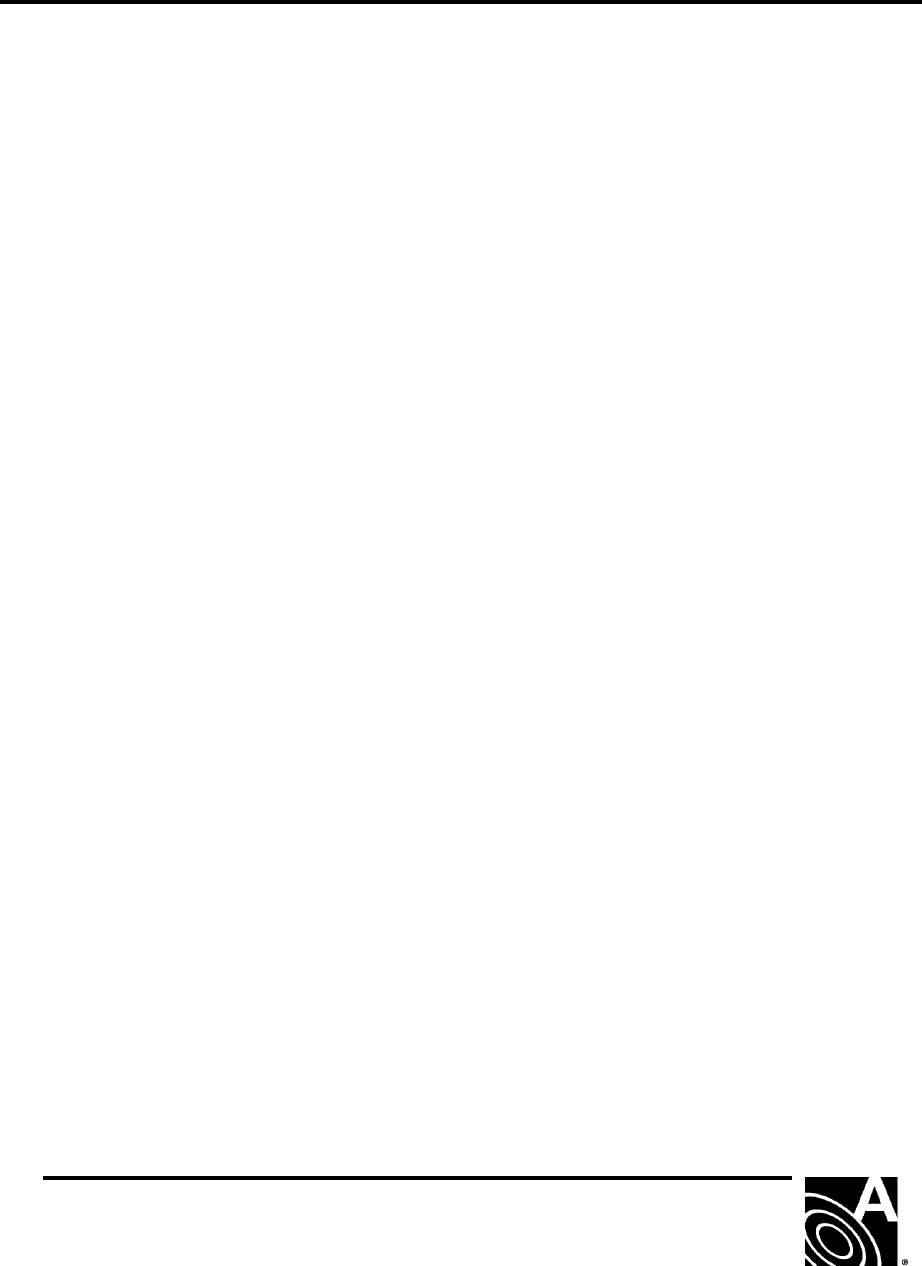
INSTRUCTION MANUAL
836A
2000 WATT UHF
TRANSLATOR
AXCERA, LLC
103 FREEDOM DRIVE P.O. BOX 525 LAWRENCE, PA 15055-0525 USA
(724) 873-8100 • FAX (724) 873-8105
www.axcera.com • info@axcera.com

836A 2 kW UHF Television Translator, Internally Diplexed Table of Contents
- Page 1 of 2 -
1. Introduction:
2. System - 836A:
A. System Description
B. Specifications
C. Site Considerations
D. Unpacking and Installation Procedures
E. Translator Set Up and Operation Procedure
F. Meters, Switches and Indicators
G. Translator Detailed Alignment Procedure
H. Remote Control Interface Connections
I. Drawings:
1. 2 kW Translator Block Diagram..................................................... 1276-3000
2. 2 kW Translator Interconnect ...................................................... 1276-8000
3. Remote Interface Assembly w/Moseley Interconnect ........................ 1276-8011
3. AC Distribution Assembly, Narrow
A. Drawings:
1. Interconnect ............................................................................ 1276-8200
4. UHF Exciter
A. Drawings:
1. Block Diagram........................................................................... 1265-3300
2. Interconnect ............................................................................ 1265-8300
5. VHF/UHF Receiver Tray
A. Drawings
1. Block Diagram........................................................................... 1265-3100
2. Interconnect ............................................................................ 1265-8100
6. UHF Amplifier Tray
A. Drawings:
1. Block Diagram........................................................................... 1281-3100
2. Interconnect ............................................................................ 1281-8100
7. Subassemblies:
Refer to the Subassembly Section of the Instruction Manual for the Schematics, of the
Boards and Modules that make up the 836A. A Subassembly Drawing List, which is a list of
the drawings in the order they appear in the Section, is located in the front of the
Subassembly Section.

836A 2 kW UHF Television Translator, Internally Diplexed Table of Contents
- Page 2 of 2 -
8. Maintenance:
This section contains information on the operation and maintenance of the 836A. This
section contains information on the Plugs, Jacks, Sockets and Pins that make up the
Harness and Cable Assemblies in the 836A.

FF WARNING!!!
×× HIGH VOLTAGE ØØ
DO NOT ATTEMPT TO REPAIR OR TROUBLESHOOT THIS EQUIPMENT
UNLESS YOU ARE FAMILIAR WITH ITS OPERATION AND EXPERIENCED
IN SERVICING HIGH VOLTAGE EQUIPMENT. LETHAL VOLTAGES ARE
PRESENT WHEN POWER IS APPLIED TO THIS SYSTEM. IF POSSIBLE,
TURN OFF POWER BEFORE MAKING ADJUSTMENTS TO THE SYSTEM.
«« RADIO FREQUENCY RADIATION HAZARD ««
MICROWAVE AMPLIFIERS AND TUBES GENERATE HAZARDOUS RF
RADIATION WHICH CAN CAUSE SEVERE INJURY INCLUDING
CATARACTS, WHICH CAN RESULT IN BLINDNESS. SOME CARDIAC
PACEMAKERS MAY BE AFFECTED BY THE RF ENERGY EMITTED BY
MICROWAVE AMPLIFIERS. NEVER OPERATE A MICROWAVE SYSTEM
WITHOUT A PROPERLY MATCHED RF ENERGY ABSORBING LOAD
ATTACHED. KEEP PERSONNEL AWAY FROM OPEN WAVEGUIDES AND
ANTENNAS. NEVER LOOK INTO AN OPEN WAVEGUIDE OR ANTENNA.
MONITOR ALL PARTS OF THE RF SYSTEM FOR RADIATION LEAKAGE
AT REGULAR INTERVALS.

EMERGENCY FIRST AID INSTRUCTIONS
Personnel engaged in the installation, operation, or maintenance of this equipment are urged to become
familiar with the following rules both in theory and practice. It is the duty of all operating personnel to be
prepared to give adequate Emergency First Aid and thereby prevent avoidable loss of life.
RESCUE BREATHING
1. Find out if the person is
breathing.
You must find out if the person
has stopped breathing. If you
think he is not breathing , place
him flat on his back. Put your
ear close to his mouth and look
at his chest. If he is breathing
you can feel the air on your
cheek. You can see his chest
move up and down. If you do
not feel the air or see the chest
move, he is not breathing.
2. If he is not, open the airway
by tilting his head backwards.
Lift up his neck with one hand
and push down on his forehead
with the other. This opens the
airway. Sometimes doing this
will let the person breathe
again by himself. If is does not,
begin rescue breathing.
3. If he is still not breathing,
begin rescue breathing.
-Keep his head tilted backward.
Pinch nose shut.
-Put your mouth tightly over his
mouth.
-Blow into his mouth once
every five seconds
-DO NOT stop rescue breathing
breathing until help comes.
LOOSEN CLOTHING - KEEP
WARM
Do this when the victim is
breathing by himself or help is
available. Keep him as quiet as
possible and from becoming
chilled. Otherwise treat him for
shock.
BURNS
SKIN REDDENED: Apply ice cold water to burned
area to prevent burn from going deeper into skin
tissue. Cover area with clean sheet or cloth to
keep away air. Consult a physician.
SKIN BLISTERED OR FLESH CHARRED: Apply ice
cold water to burned area to prevent burn from
going deeper into skin
tissue. Cover area with clean sheet or cloth to
keep away air. Treat victim for shock and take
to hospital.
EXTENSIVE BURN - SKIN BROKEN: Cover area
with clean sheet or cloth to keep away air. Treat
victim for shock and take to hospital.

LIMITED WARRANTY
ONE YEAR
Seller warrants each new product manufactured and sold by Seller against
defects in material and workmanship under normal use and service, for a
period of one (1) year from the date of shipment from Seller's plant, when
operated in accordance with Seller's operating instructions. This warranty
shall not apply to tubes, fuses, batteries, or bulbs.
Warranties are valid only when and if (a) Seller receives prompt written
notice of breach within the period of warranty, (b) the defective product is
properly packed and returned by the Buyer (transportation and insurance
prepaid), and (c) Seller determines, in its sole judgment, that the product is
defective and not subject to any misuse, neglect, improper installation,
negligence, accident, or (unless authorized in writing by Seller) repair or
alteration. Seller's exclusive liability for any personal and/or property damage
(including direct, consequential or incidental) caused by the breach of any or
all warranties, shall be limited to the following: (a) repairing or replacing (in
Seller's sole discretion) any defective parts free of charge (F.O.B. Seller's
plant), and/or (b) crediting (in Seller's sole discretion) all or a portion of the
purchase price to the Buyer.
Equipment furnished by Seller, but not bearing its trade name, shall bear no
warranties other than the special hours-of-use or other warranties extended
by or enforceable against the manufacturer at the time of delivery to the
buyer. NO WARRANTIES, WHETHER STATUTORY, EXPRESSED OR
IMPLIED, AND NO WARRANTIES OF MERCHANTABILITY, FITNESS FOR
ANY PARTICULAR PURPOSE, OR FREEDOM FROM INFRINGEMENT, OR THE
LIKE, OTHER THAN AS SPECIFIED IN PATENT LIABILITY ARTICLES, AND
IN THIS ARTICLE, SHALL APPLY TO THE EQUIPMENT FURNISHED
HEREUNDER.
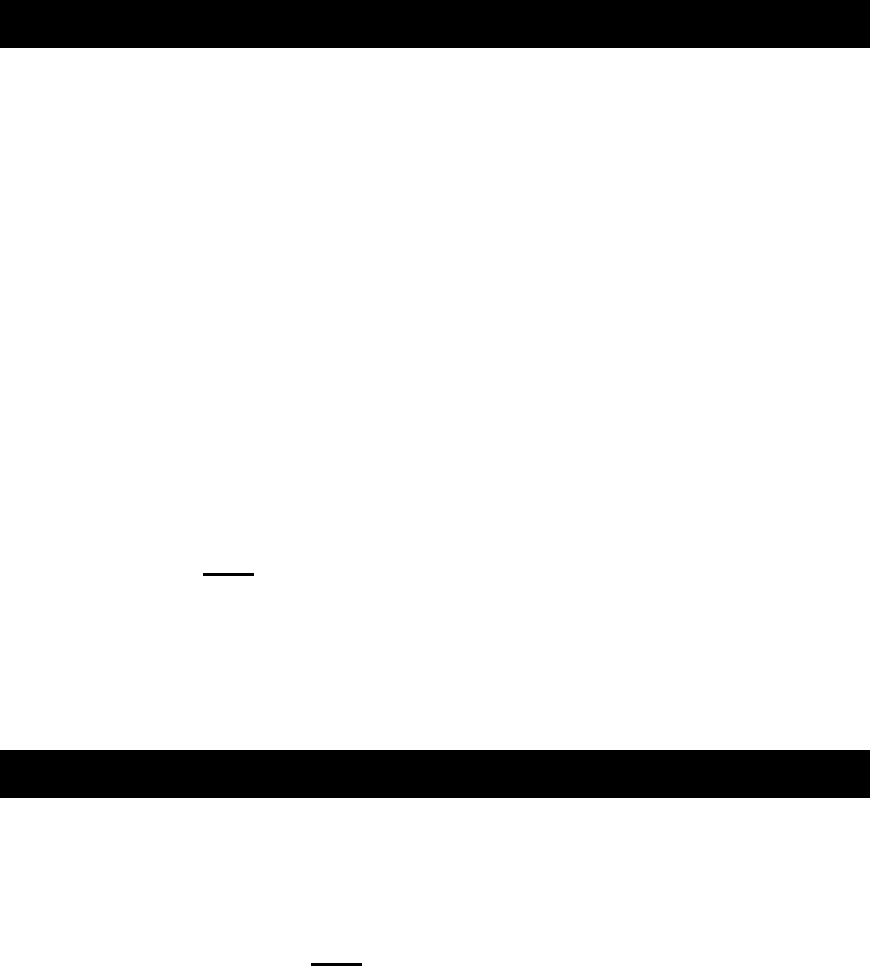
))MATERIAL RETURN PROCEDURE
In order to efficiently handle equipment or components returned for repair or sent out on loan,
Axcera requests that each returned item be accompanied by a Material Return Authorization
Number (MRA#).
To obtain an MRA follow the procedures below:
pp Call Axcera Customer Service at (724)-873-8100
or FAX (724) 873-8105
pp A Service Engineer will provide you with an MRA#
pp Write the MRA# on the packing list or in the case of repairs, a
note describing the reason for return. Also, be sure to include contact
information.
pp Send ALL MRA items to the following address
Axcera, LLC
103 Freedom Drive P.O. Box 525
Lawrence, PA 15055-0525
%% TELEPHONE TECHNICAL SUPPORT
Axcera currently provides free telephone technical support. When calling, be prepared to
provide the following information:
pp Transmitter model # AND Serial #
pp Status of front panel LED’s (are any red LED’s on ?)
pp Have a copy of your operation manual ready prior to calling
From 8:00 AM - 5:00 PM EST call (724) 873-8100 for technical support

..PROPER PACKING OF MATERIALS
When returning materials to Axcera, it is extremely important to pack them properly. Due to the
delicate nature of components contained within the equipment, major damage can occur without
proper packing. Please adhere to the following guidelines when returning materials.
oo Save the boxes that the transmitter is shipped in. Each tray is sent
double boxed and enclosed in foam padding. Use the same packing
method when returning materials.
Failure to properly pack any returned materials may result in damage to the
equipment. Axcera is not responsible for damaged equipment under these
circumstances. Many freight companies will not compensate for damages when items
are not packed properly. Please pack items properly!
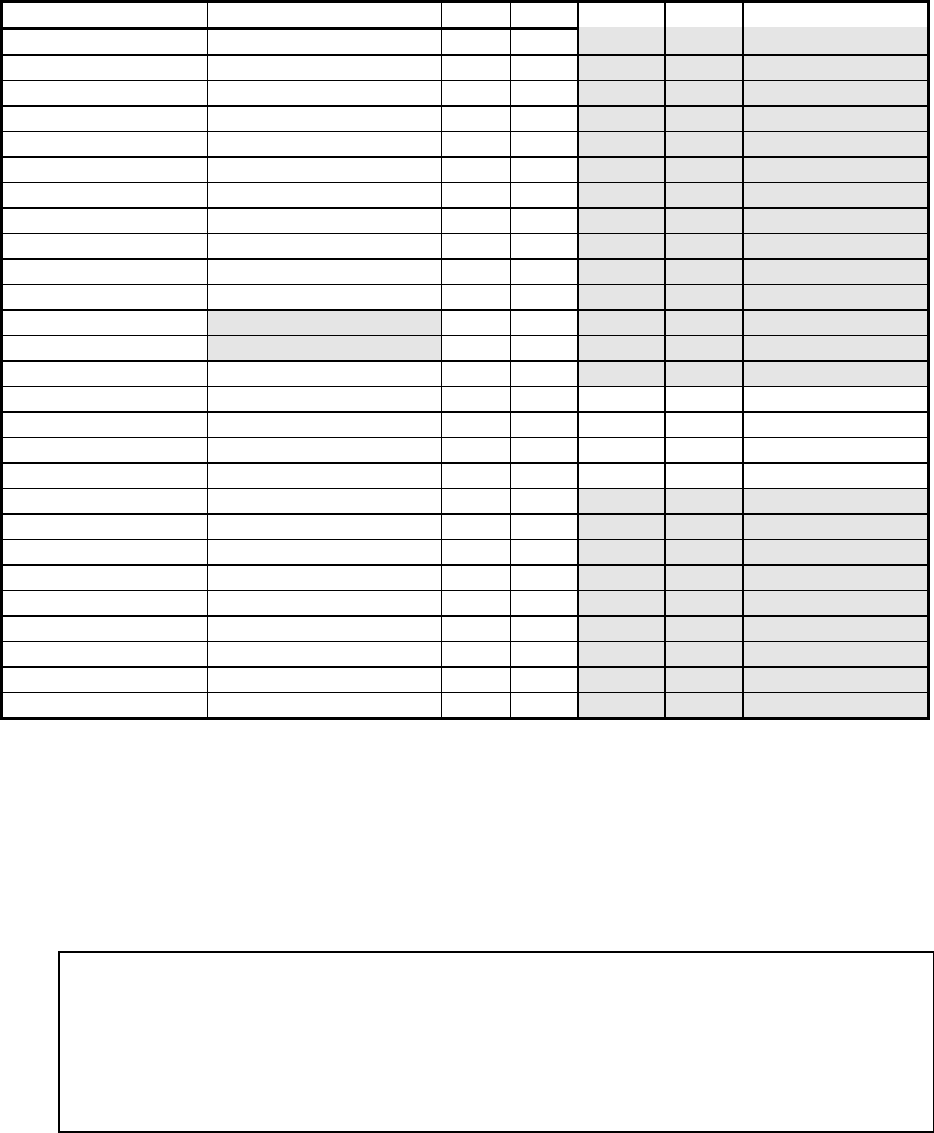
dBm, dBw, dBmV, dBµµV, AND VOLTAGE EXPRESSED IN WATTS
50 ohm system
WATTS PREFIX dBm dBw dBmV dBµVVOLTAGE
1,000,000,000,000 1 TERAWATT +150 +120
100,000,000,000 100 GIGAWATTS +140 +110
10,000,000,000 10 GIGAWATTS +130 +100
1,000,000,000 1 GIGAWATT +120 + 99
100,000,000 100 MEGAWATTS +110 + 80
10,000,000 10 MEGAWATTS +100 + 70
1,000,000 1 MEGAWATT + 90 + 60
100,000 100 KILOWATTS + 80 + 50
10,000 10 KILOWATTS + 70 + 40
1,000 1 KILOWATT + 60 + 30
100 1 HECTROWATT + 50 + 20
50 + 47 + 17
20 + 43 + 13
10 1 DECAWATT + 40 + 10
1 1 WATT + 30 0+ 77 +137 7.07V
0.1 1 DECIWATT + 20 - 10 + 67 +127 2.24V
0.01 1 CENTIWATT + 10 - 20 + 57 +117 0.707V
0.001 1 MILLIWATT 0- 30 + 47 +107 224mV
0.0001 100 MICROWATTS - 10 - 40
0.00001 10 MICROWATTS - 20 - 50
0.000001 1 MICROWATT - 30 - 60
0.0000001 100 NANOWATTS - 40 - 70
0.00000001 10 NANOWATTS - 50 - 80
0.000000001 1 NANOWATT - 60 - 90
0.0000000001 100 PICOWATTS - 70 -100
0.00000000001 10 PICOWATTS - 80 -110
0.000000000001 1 PICOWATT - 90 -120
TEMPERATURE CONVERSION
°°F = 32 + [(9/5) °°C]
°°C = [(5/9) (°°F - 32)]
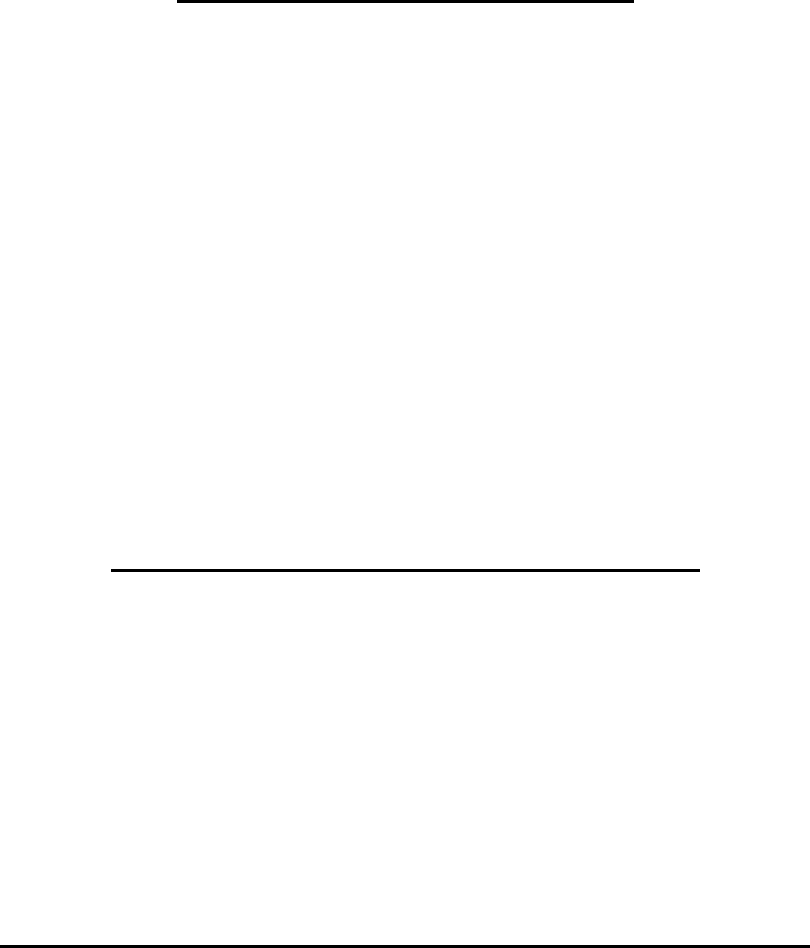
USEFUL CONVERSION FACTORS
TO CONVERT FROM TO MULTIPLY BY
mile (US statute) kilometer (km) 1.609347
inch (in) millimeter (mm) 25.4
inch (in) centimeter (cm) 2.54
inch (in) meter (m) 0.0254
foot (ft) meter (m) 0.3048
yard (yd) meter (m) 0.9144
mile per hour (mph) kilometer per hour(km/hr) 1.60934
mile per hour (mph) meter per second (m/s) 0.44704
pound (lb) kilogram (kg) 0.4535924
gallon (gal) liter 3.7854118
U.S. liquid
(One U.S. gallon equals 0.8327 Canadian gallon)
fluid ounce (fl oz) milliliters (ml) 29.57353
British Thermal Unit watt (W) 0.2930711
per hour (Btu/hr)
horsepower (hp) watt (W) 746
NOMENCLATURE OF FREQUENCY BANDS
FREQUENCY RANGE DESIGNATION
3 to 30 kHz VLF - Very Low Frequency
30 to 300 kHz LF - Low Frequency
300 to 3000 kHz MF - Medium Frequency
3 to 30 MHz HF - High Frequency
30 to 300 MHz VHF - Very High Frequency
300 to 3000 MHz UHF - Ultrahigh Frequency
3 to 30 GHz SHF - Superhigh Frequency
30 to 300 GHz EHF - Extremely High Frequency
LETTER DESIGNATIONS FOR UPPER FREQUENCY BANDS
LETTER FREQ. BAND
L 1000 - 2000 MHz
S 2000 - 4000 MHz
C 4000 - 8000 MHz
X 8000 - 12000 MHz
Ku 12 - 18 GHz
K 18 - 27 GHz
Ka 27 - 40 GHz
V 40 - 75 GHz
W 75 - 110 GHz

ABBREVIATIONS/ACRONYMS
AC Alternating Current
AFC Automatic Frequency Control
ALC Automatic Level Control
AM Amplitude modulation
AGC Automatic Gain Control
AWG American wire gauge
BER Bit Error Rate
BW Bandwidth
DC Direct Current
D/A Digital to analog
dB Decibel
dBm Decibel referenced to 1 milliwatt
dBmV Decibel referenced to 1 millivolt
dBw Decibel referenced to 1 watt
FEC Forward Error Correction
FM Frequency modulation
Hz Hertz
ICPM Incidental Carrier Phase Modulation
I/P Input
IF Intermediate Frequency
LED Light emitting diode
LSB Lower Sideband
MPEG Motion Pictures Expert Group
O/P Output
PLL Phase Locked Loop
PCB Printed circuit board
QAM Quadrature Amplitude Modulation
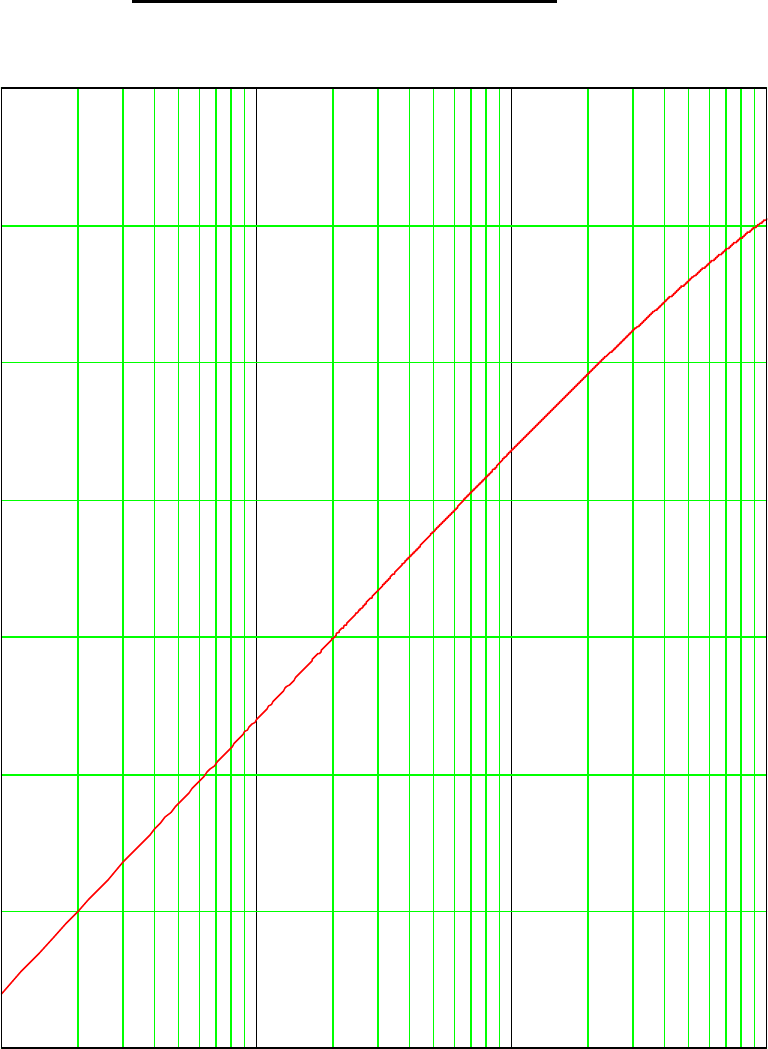
RETURN LOSS VS. VSWR
1.001 1.01 1.1 2.0
VSWR
0
-10
-20
-30
-40
-50
-60
-70
R
E
T
U
R
N
L
O
S
S
dB

836A 2 kW UHF Translator, Internally Diplexed System Description
- Page 1 of 3 -
The 836A is a complete 2 kW UHF Solid State Internally Diplexed Television Translator which
operates at a nominal Visual Output Power of 2000 Watts Peak of Sync and with an Average Aural
Output Power of 200 Watts at an A/V Ratio of 10 dB, 10 % Sound. The Translator uses the
combined IF Output of the Receiver Tray as the input to the UHF Exciter Tray.
The 836A (1078476) is functionally comprised of (A4) the UHF Exciter (1300-1020), (A3) the
VHF/UHF Receiver Tray (1265-1100), (A5) the 4 Way Splitter Assembly, (A6, A7, A8 & A9) four
UHF Amplifier Trays (1294-1112, 1294-1113 or 1294-1114), (A10 & A11) two UHF Tee Assemblies,
(A12) a Hybrid Combiner, (A13) a Bandpass Filter, (A14) an (Optional) UHF Trap Filter, (A16) a
Coupler Assembly, (A2) an AC Distribution Assembly (1276-1200) and (A17) an (Optional) A/V
Input & Remote Interface Assembly (1276-1008) or a Remote Interface Assembly w/Moseley
(1314-1008).
The (A3) VHF/UHF Receiver Tray (1265-1100) takes the On Channel RF Input, which connects to
J5 for 75Ω or J1 for 50Ω on the rear of the Tray and generates a Modulated Diplexed IF Output.
The Combined IF from J4 connects to the J6 on the (A4) UHF Exciter Tray (1265-1300) which
upconverts the signal to the On Channel Frequency Visual + Aural RF Output. The RF Output of
the UHF Exciter at J15 is split four ways by (A5) the Four Way Splitter Assembly (ZFSC-4-1SMA).
The outputs of the Splitter feed to J1 on the four (A6, A7, A8 & A9) UHF Amplifier Trays. The RF
outputs of the (A8 & A9) UHF Amplifier Trays are combined in the (A11) UHF Tee Assembly and the
outputs of the (A6 & A7) UHF Amplifier Trays are combined in the (A10) UHF Tee Assembly. The
Combined Outputs of each UHF Tee are combined in (A12) a Hybrid Combiner. A 500 Watt Dummy
Load (A18) is connected to the Hybrid Combiner and provides Transmitter protection, using the
Thermal Switch (A18-A1), in case of misalignment in the combining or a malfunction in the UHF
Amplifier Trays which causes overtemperature. The RF output of the Hybrid Combiner is connected
to (A13) a Bandpass Filter, and then either directly to (A16) an Output Coupler Assembly or
through (A14) an (Optional) One Section or Two Section UHF Trap Filter. The 7/8” RF Output at
J2 of the Coupler is the output of the Translator. The (A16) 7/8" Coupler Assembly supplies a
Forward Power Sample and a Reflected Power Sample to the Visual/Aural Metering Board located in
the UHF Exciter. The Samples are peak detected and wired to the Transmitter Control Board which
connects the Visual, Aural and Reflected Power Output Samples to the front panel Meter on the
Exciter for monitoring.
The Combined Visual IF + Aural IF Input (0 dBm Typical) from the Receiver Tray connects to J6 on
the UHF Exciter Tray. The Combined IF is cabled to the (A8) ALC Board (1265-1305) which gives
the operator control over the output power level of the Translator by adjusting the level of the
combined IF Signal. The IF Signal is fed out of the ALC Board to (A9) an IF Phase Corrector Board
(1227-1250) that is adjusted for best signal and then back to the ALC Board.
Upconverter Section
The output of the ALC Board (0 dBm) connects to (A11) the UHF Upconverter Board (1265-1310),
located in the Upconverter Section, which takes the L.O. and heterodynes it with the Combined IF,
that is then filtered to produce the RF On Channel Output. The crystal frequency needed to
generate the L.O. is produced by (A14-A1) the Channel Oscillator Board (1145-1201) located in
(A14) the Channel Oscillator Assembly (1145-1202) or if the Optional FSK Identifier Kit is
purchased, by the VCXO Channel Oscillator Board (1145-1204) located in the VCXO Channel
Oscillator Assembly (1145-1206). The Crystal Frequency (+5 dBm) is multiplied 8 times by (A15-
A1) the x8 Multiplier Board (1227-1002), located in (A15) the x8 Multiplier Enclosure (1265-1347),
which produces the L.O. Signal at the proper frequency (+16 dBm) needed in the upconversion
process that takes place on the UHF Upconverter Board. The L.O. is filtered by (A16) a UHF Filter
(1007-1101) before it is applied to the UHF Upconverter Board. The L.O. is mixed with the IF to
produce an On Channel RF Output that is filtered by (A12) a UHF Filter (1007-1101) and connected
back to the Upconverter Board. The RF is connected through an AGC circuit and is amplified
before it is attached to the output of the board.

836A 2 kW UHF Translator, Internally Diplexed System Description
- Page 2 of 3 -
Output RF Section
The RF Output of the UHF Exciter is split four ways in (A5) the 4 Way Power Splitter Assembly
(ZFSC-4-1SMA). The outputs of the Splitter feed the four (A6, A7, A8 & A9) UHF Amplifier Trays
which amplify the RF signals to approximately 600 Watts each. A Forward Power Sample from the
4 Way Combiner Board inside the Tray is connected to the Dual Peak Detector Board which
provides a peak detected forward sample to the Amplifier Control Board that supplies the sample to
the front panel meter of the UHF Amplifier Tray. Before exiting each UHF Amplifier Tray the RF is
fed through a Circulator for protection of the Tray from high VSWR conditions. The Reject Port of
the Circulator provides a Reject Sample to the 4 Way Combiner Board, which supplies the Reflected
Sample to the Dual Peak Detector Board. The peak detected Reflected Sample connects to the
Amplifier Control Board that provides the sample to the front panel meter of the Tray. The outputs
of the two (A6 & A7) UHF Amplifier Trays are then combined in (A10) a UHF Tee Assembly (1227-
1017 L.B., 1227-1018 M.B. or 1227-1019 H.B.) that provides approximately 1100 Watts Peak of
Sync Output. The outputs of the other two (A8 & A9) UHF Amplifier Trays are then combined in
(A11) a UHF Tee Assembly (1227-1017 L.B., 1227-1018 M.B. or 1227-1019 H.B.) that provides
approximately 1100 Watts Peak of Sync Output. The two 1100 Watts Outputs then combined in
(A12) a Hybrid Combiner that provides approximately 2200 Watts Peak of Sync Output. The
combined output is connected to (A13) a Bandpass Filter, then either through (A14) an (Optional)
One Section or Two Section Trap Filter or directly to (A16) the Output Coupler Assembly to the
output of the System. The Bandpass Filter and Trap Filter are tuned to provide high out of band
rejection of unwanted products. The (A16) 7/8" Coupler Assembly provides a Forward Power
Sample and a Reflected Power Sample. The Forward and Reflected Samples are cabled to the
Visual/Aural Metering Board located in the UHF Exciter. The Forward and Reflected Samples are
processed to provide peak detected Visual and an Aural Power Output Samples to the Transmitter
Control Board. The Transmitter Control Boards connect the Visual, Aural and Reflected Power
Output Samples to the front panel Meter for monitoring.
Control and Status
The Meter and the LED indicators located on the front panel of the UHF Exciter provide the Control
and the Status Indications of the Translator. The switches and LED indicators are part of the
Transmitter Control Board (1265-1311) which is mounted so that the switches and the LEDs are
operated or viewed from the front Panel of the UHF Exciter. Switch (S1) is an Operate/Standby
Switch that controls the output of the Translator by providing the Enables, when in Operate,
needed to turn on the Switching Power Supplies in the four UHF Amplifier Trays. In Operate the
Green LED (DS2) is On and when in Standby the Amber LED (DS1) is On. If the Translator does
not switch to Operate, when S1 is switched to Operate, check that a Dummy Jumper Plug, with a
Jumper between Pins 23 & 24 is connected to J11 on the rear of the UHF Exciter Tray or with a
jumper between Pins 21 & 22 on Jack J9 on (A17) the (Optional) A/V Input & Remote Interface
Panel. This Jumper provides the Interlock needed for the Translator to operate. If the Interlock is
present the Green LED (DS5), located on the Transmitter Control Board, should be lit.
Switch (S2) is an Automatic/Manual Switch that controls the operation of the Translator by the
presence of the Input Signal. When the switch is in Automatic the Green LED (DS3) is lit and if the
Input Signal to the Translator is lost, the Translator will automatically switch to Standby. When
the Input Signal returns the Translator will automatically switch back to Operate. In Manual,
Amber LED (DS4) lit, the Operation of the Translator is controlled by the front panel switches.
During Normal operation of the Translator Switch S2 should be in the Auto position. The front
panel of the UHF Exciter also has LEDs that indicate a Video Fault (Loss), Red LED (DS9) and a
VSWR Cutback, Amber LED (DS7).

836A 2 kW UHF Translator, Internally Diplexed System Description
- Page 3 of 3 -
Operation of the Translator
The Translator needs an AC input of 220 VAC at 80 Amps connected to it in order to operate. The
220 VAC Input connects to the Terminal Block (TB1), located in the upper right rear of the
Cabinet, that is part of (A2) the AC Distribution Panel (1276-1200). The AC Distribution Panel
contains Six Circuit Breakers that supply the AC to the rest of the Translator.
The Input AC from TB1 is connected to (CB1) the Main AC Circuit Breaker (80 Amps) which
distributes the 220 VAC to the Terminal Block (TB2). TB2 has three MOVs, mounted to the
Terminal Block, one connected from each leg of the Input AC to ground and one across the two
legs. The Input AC is wired from TB2 through five Circuit Breakers, CB2, CB3, CB4, CB5 & CB6 to
the rest of the Translator. CB2 (10 Amps) supplies the AC voltage to the IEC Outlet Strip (A1)
into which the UHF Exciter, the Optional Receiver Tray and any other Optional Accessories are
connected. CB3 (20 Amps) supplies AC through J5 to the (A6) UHF Amplifier Tray. CB4 (20 Amps)
supplies AC through J6 to the (A7) UHF Amplifier Tray. CB5 (20 Amps) supplies AC through J7 to
the (A8) UHF Amplifier Tray. CB6 (20 Amps) supplies AC through J8 to the (A9) UHF Amplifier Tray.
When the UHF Exciter circuit breaker is switched On, +12 VDC is supplied to the UHF Amplifier
Trays for operation of the LED Status Indicators in the Tray.
Input and Remote Connections
The On Channel RF Input from the Antenna connects to J5 for 75Ω or J1 for 50Ω located on the
rear of the VHF/UHF Receiver Tray. Jacks J10 and J11 on the rear of the UHF Exciter provides
connections for Remote Monitoring and Operation of the Translator. Jack (J11) should have a
dummy plug connected to it which has a jumper between Pins 23 & 24 that provides the Interlock
needed to operate the Translator. If remote connections are made to the Translator they should
be made through the plug in J10 or J11 in the positions noted on the Interconnect Drawing (1276-
8000).
The (Optional) Remote Interface Assembly, if present, provides connections for Remote Monitoring
and Operation of the Translator at Jack (J9 & J10). Jack (J9) should have a dummy plug
connected to it which has a jumper between Pins 21 & 22 that provides the Interlock needed to
operate the Translator. If remote connections are made to the Translator they should be made
through the plug in J9 or J10 in the positions noted on the Interconnect Drawing (1276-8000).
Instruction Manual Description
The Instruction Manual is divided into sections that are labeled as to their contents. The first
main section is the System Section that contains the Parameters and Specifications of the 836A
along with the Site Preparation, Installation, System Set Up, Alignment and Operation Procedures.
The Block Diagram and Interconnect for the Translator are also found in the System Section.
The Manual is further divided into Tray and Assembly Sections. Each Tray or Assembly Section of
the Manual contains the Block Diagrams, Control Location Drawings and Interconnects of that
Assembly or Tray. Each of the Sections also contains the Circuit Descriptions and Detailed
Alignment Procedures for that Tray or Assembly.
The Schematics, Parts Location Drawings and the Replacement Parts Lists for the individual boards
that make up the Trays and Assemblies in the Translator are located in the Subassembly Section
of the Manual. There is a Drawing List at the beginning of the Subassembly Section that lists the
drawings in the order they appear in the section.
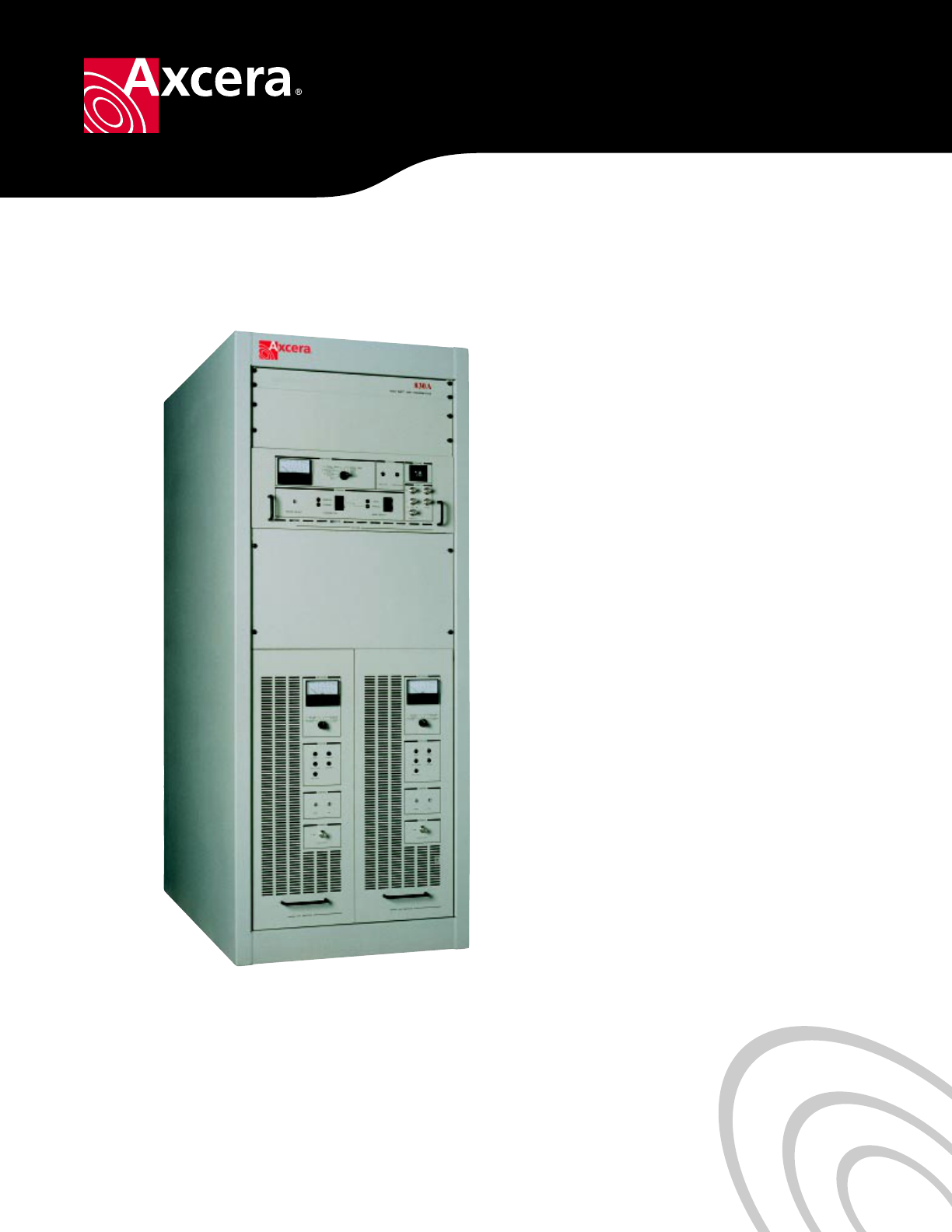
UHF Solid State Transmitter / Translator
825A / 827A - 500W
830A / 832A - 1kW
834A / 836A - 2kW
These products represent the state of the art in
solid state UHF transmitters. High performance,
redundancy, and simplicity are combined in a
very compact unit. Multiplexed aural/visual
amplification is achieved with very good
intermodulation performance, thanks to highly
linear amplifiers and extensive correction
capability.
Front panel samples, status, and metering, most
of which are remote controllable, allow for
convenient system monitoring. As with all
Axcera products, servicing is made easy with
slide out assemblies that require no extender
cards. This allows the circuits to be accessed for
maintenance or adjustments even while on the
air.

www.axcera.com • 724-873 -1500
UHF Solid State Transmitter / Translator
UHF Solid State Transmitter / Translator
Exciter
The exciter, designed and
built by Axcera, contains the
circuitry to convert the input
video and audio signals to a
combined, modulated RF
signal which drives the
power amplifiers. In the
translator version, a receiver
replaces the modulator
circuits to accept an off air
RF input and convert it to IF.
An optional Frequency
Correcting Receiver (FCR) is
available, which uses a
phase locked loop to correct
frequency errors from the
incoming signal. This option
is especially useful in
multiple hop translator
systems.
Video/Visual Modulation
The video signal is processed
in several ways prior to
modulation. Sync tip
clamping is provided to
restore proper DC level.
Sync and white clipping are
also included to limit video
transient faults. Back porch
clamping is also available for
some scrambling systems.
The video signal is then
applied to a double balanced
diode modulator, providing
modulation capability to 1%
at standard intermediate
frequency (IF). A SAW filter
is employed for precise
sideband filtering with
minimal group delay error.
Audio/Aural Modulation
The audio signal is applied to
a very wideband, linear FM
modulator which operates at
intercarrier frequency (4.5
MHz for system M). The
high performance modulator
readily accepts the full range
of multichannel sound
signals. Standard aural IF is
achieved by heterodyne
conversion of the modulated
intercarrier signal with the
visual IF.
IF Processing
The visual and aural
modulated IF signals are
combined and applied to IF
processing stages. These
stages provide outstanding
signal precorrection to yield a
very linear transmitter
output. Amplitude linearity,
incidental carrier phase
modulation (ICPM), and
frequency response
correction are all adjustable.
Upconversion
The IF signal is upconverted
to final channel frequency
through heterodyning with a
very stable local oscillator.
The oscillator is crystal
controlled, and embedded in
two ovens for tight stability.
The exciter is controlled with
an Automatic Level Control
(ALC) loop which ensures
stable signal levels. After
upconversion the signal is
amplified to provide the
exciter output.
Power Amplifiers
The 600 watt power
amplifiers are high gain units
producing 45 to 50dB of
gain. Operating in parallel in
the 1 and 2kW versions,
these trays provide
redundant paths from the
exciter output to the
bandpass filter. Redundancy
is enhanced with
independent power supplies
and cooling for each
amplifier assembly.
Furthermore, the output
stage of each amplifier tray
employs eight transistors in
parallel for added
redundancy.
A high degree of protection
is provided with each
amplifier. Individual
circulators, overdrive
protection, VSWR cutback,
and overtemperature
protection are all included.
AGC around each amplifier
ensures that the transmitter
output remains stable.
An integrated output
bandpass and trap filter is
included to provide superior
out of band rejection. This
network also adds lightning
protection through the
quarter wave stub of the trap
filter (DC and lightning short)
and the DC short circuit of
the band pass filter.
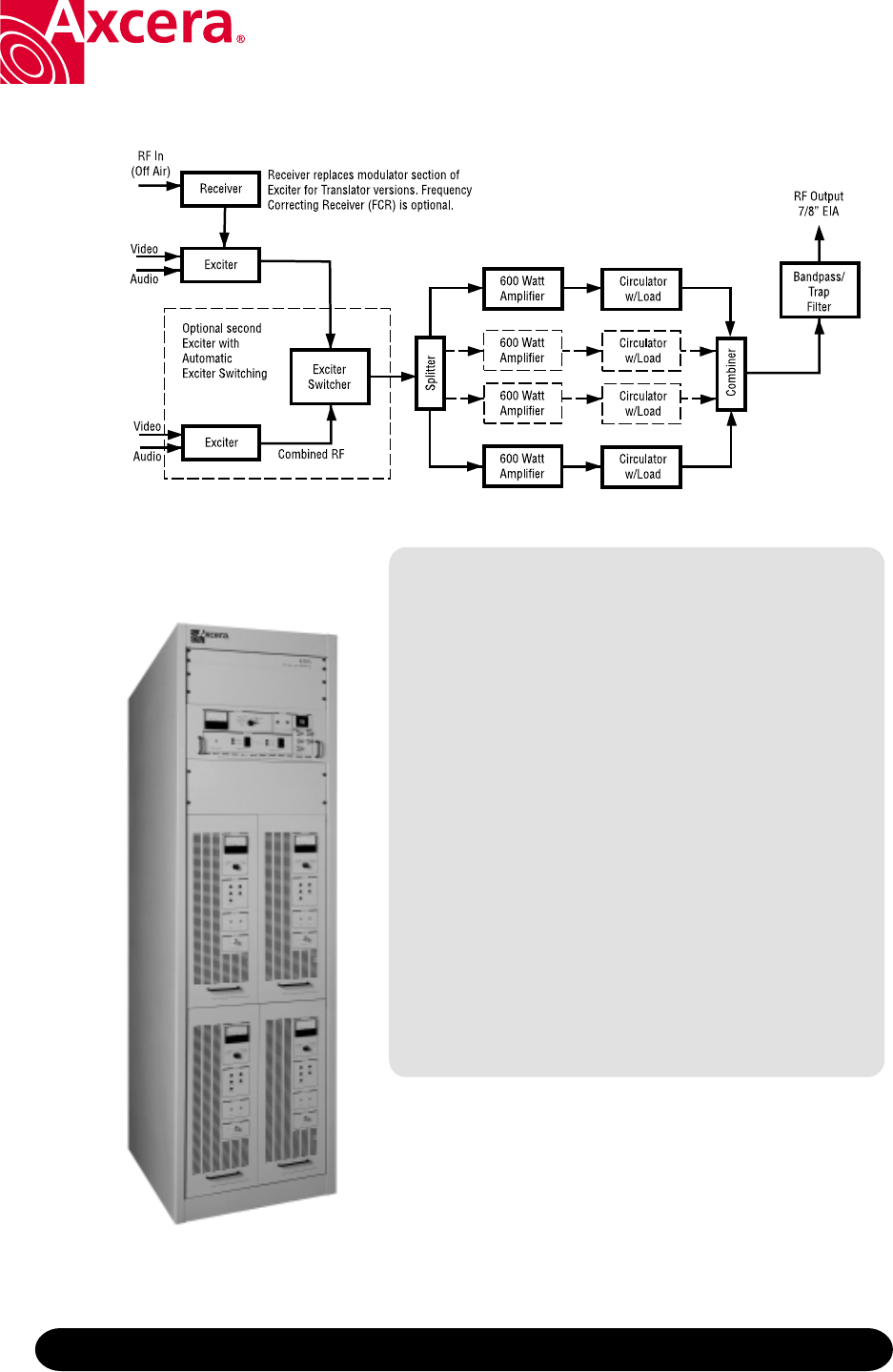
www.axcera.com • 724-873 -1500
UHF Solid State Transmitter / Translator
■Utilizes 100% solid state circuitry for high reliability
and low maintenance costs
■1kW and 2kW configured with parallel high gain
amplifiers, separate power supplies and cooling
for excellent redundancy, including driver stages
■Packaged in a compact design, completely
contained in a single rack - including output
filters!
■Provides standard ±1 kHz frequency stability for
stations with an offset frequency
■Configured with broadcast quality exciter
that includes full BTSC sound capability
■Provides output circulator amplifier protection
for high VSWR conditions
■Experienced field service/support team is ready to
help you 24 hours a day, 7 days a week.
Standard with all Axcera products is 24 hour/day, 7 day/week
customer support. This service operates as a direct telephone
line during business hours, and on a pager system at all other
times. Since all our products are designed and built at our
facility just south of Pittsburgh, Pennsylvania, we are able to
offer quick turnaround on most replacement modules, and
timely shipping from the Pittsburgh International Airport.
UHF Solid State Transmitter / Translator

B0007 1101R1-E
UHF Solid State Transmitter / Translator
Visual Performance
Power Output (Peak) 500, 1000, 2000 W
Output Impedance 50 ohms
Output Connector 7/8" EIA
Frequency Range* 470 to 806 MHz
Carrier Stability (Transmitters) ±1 kHz (standard)
±350 Hz (optional)
Frequency Translation Stability ±1 kHz (standard)
(Translators) ±350 Hz (optional)
Regulation of RF Output Power 3%
Output Variation (over 1 frame) 2%
Sideband Response (System M/N-others on request)
-1.25 MHz and below -20 dB
-0.75 to -0.5 MHz +0.5 dB, -2 dB
-0.5 to +3.58 MHz ±0.5 dB
+3.58 MHz to +4.18 MHz +0.5 dB, -1 dB
Freq Response vs. Brightness ±0.5 dB
Visual Modulation Capability 1%
(Transmitters)
Differential Gain 5%
Incidental Phase Modulation ±3°
Linearity (Low Frequency) 5%
Differential Phase ±3°
Signal-to-Noise Ratio 55 dB
2t K-Factor 2%
Noise Figure (Translators) 5 dB (max.)
w/input Preamp 3 dB (max.)
Input Dynamic Range -60 dBm to -15 dBm
(Translators)
w/input Preamp -75 dBm to -30 dBm
Env. Delay (Transmitters) Per CCIR or FCC
Standard
Env. Delay .02 to 4.18 MHz ±40 ns
(Translators)
Video Input (Transmitters) 75 ohms
(loop through)
Harmonics -60 dB or better
Intermodulation Products -52 dB or better
Spurious -60 dB or better
(>3 MHz from channel edge)
Aural Performance
Power Output (Average) 50, 100, 200 W
Frequency Deviation Capability ±75 kHz
(Transmitters)
Distortion 0.5%
FM Noise -60 dB
AM Noise -50 dB
Aural to Visual Separation 4.5 MHz, ±100 Hz
Composite Audio Input (multi-channel sound)
(Transmitters)
Input Level 1V peak, nominal
Input Impedance 75 ohms, unbalanced
Frequency Range
±0.1 dB response 50 Hz to 50 kHz
±0.5 dB response 30 Hz to 120 kHz
Monaural Audio Input (Transmitters)
Input Level 0 to +10 dBm
Input 600 ohms, balanced
Freq Range (±0.5 dB resp) 30 Hz to 15 kHz
Pre-emphasis 75µs
Subcarrier Input (Transmitters)
Input Level 1V peak, nominal
Input Impedance 75 ohms, unbalanced
Freq Range (±0.5 dB resp) 20 kHz to 120 kHz
General
Operational Temperature Range -30°C to +50°C
Operational Humidity Range 0% to 95%
Altitude* 8,500 feet
825A/827A
Size (H x W x D) 55" x 22" x 34"
Weight 320 lbs
Power Consumption 1800 watts (50% APL)
830A/832A
Size (H x W x D) 55" x 22" x 34"
Weight 400 lbs
Power Consumption 3500 watts (50% APL)
834A/836A
Size (H x W x D) 76" x 22" x 34"
Weight 750 lbs
Power Consumption 7000 watts (50% APL)
Line Voltage* 230V ±10%, 1 phase,
50/60 Hz
*Consult factory for other frequencies, altitudes and line voltages

836A 2 kW UHF Translator, Internally Diplexed Site Considerations
- Page 1 of 3 -
There are special considerations that need to be made before installing the 836A and this section
will help you plan ahead.
The Translator requires an AC Input Line of 220 VAC with a rating of 80 Amps. Check that the site
has the voltage requirement needed.
836A is designed and built to provide long life with a minimum of maintenance. The environment in
which it is placed is important and certain precautions must be taken. The three greatest dangers
to your Translator are heat, dirt and moisture. Heat is usually the greatest problem, followed by
dirt and then moisture. Over-temperature can cause heat related problems such as thermal
runaway and component failure. Each Amplifier Tray in the Translator contains a Thermal Interlock
Protection Circuit that will shut down that Tray until the temperature drops to an acceptable level.
To begin to design a suitable environment for your new Translator it is imperative that you
understand what an "Ideal Environment" is and how it can enhance the overall performance and
reliability of your Translator, thereby maximizing revenues by minimizing down time. A properly
designed facility will have an adequate supply of cool clean air, free of airborne particulates of any
kind, and without excessive humidity. An Ideal Environment will require temperature in the range
of 40 degrees F to 70 degrees F year round, reasonably low humidity and a dust free room. It
should be noted that this is rarely if ever attainable in the real world. However, the closer your
environment is to the Ideal Environment the greater the operational elevation. A heat related
problem may not surface for many months if the installation is completed during cool weather, but
may suddenly appear during the heat of summer.
The fans and blowers designed and built into your Translator will remove the heat from within the
cabinet but additional means is required for removing this heat from the building. In doing this a
few considerations should be noted. The first step is to determine the amount of heat to be
removed. There are generally three sources of heat that must be considered. The first and most
obvious is the heat from the 2 kW Translator itself. This can readily be determined by subtracting
the Average Power to the Antenna (1290 Watts) from the AC Input Power (8000 W). These
numbers will be different for the 5 kW and 10 kW Translator but can be found by referring to the
published literature or directly from Axcera. This number in Watts (6710) is then multiplied by 3.41
which gives (22881.1) the BTU's to be removed every hour. 12,000 BTU's per hour equals one ton,
so a two-ton air conditioner will cool a 2 kW Translator. The second source of heat is other
equipment in the same room. Calculate this number as you did above. The third source of heat is
equally obvious but not as simple to calculate. This is the heat coming through the walls, roof and
windows on a hot summer day. Unless the underside is exposed, the floor is usually not a problem.
Determining this number is usually best left up to a qualified HVAC Technician. There are far too
many variables to even estimate this number without detailed drawings of the site showing all
construction details. The sum of these three sources is the total amount of heat that must be
removed. There may be other sources of heat, such as personnel, and all should be taken into
account.
Now that you know the amount of heat that must be removed we will consider how this can be
accomplished. Your options are air conditioning, ventilation or a combination of the two. Air
conditioning is always the preferred method and is the only way to approach the Ideal
Environment.
Ventilation will work quite well if the ambient air temperature will be below 100 degrees F or about
38 degrees C and the humidity should be at a reasonable level. In addition, the air stream must be
adequately filtered to ensure that no airborne particulate of any kind will be carried into the
Translator. The combination of air conditioning for summer and ventilation during the cooler
months is acceptable when the proper cooling cannot be obtained through the use of ventilation
alone and air conditioning year round is not feasible for whatever reason. However, operation of
air conditioning and ventilation simultaneously is not recommended because this can cause

836A 2 kW UHF Translator, Internally Diplexed Site Considerations
- Page 2 of 3 -
condensation in Translators. For tube type Translators this can be especially serious if the
condensation forms in the tube cavity and creates damaging arcs.
A few cautions should be observed concerning an air conditioning system.
1. Air conditioners have an ARI nominal cooling capacity rating. In selecting your air
conditioner do not assume you can equate this number to your requirements. Make certain
that your contractor uses the actual conditions you wish to maintain in determining the size
of the unit. With desired conditioned room temperature under 80 degrees F the unit must be
derated, possibly by a substantial amount.
2. Do not have the air conditioner blowing directly onto the Translator. Condensation may
occur on, or worse, in the Translator under certain conditions.
3. Do not isolate the front of the Translator from the back with the thought of air conditioning
the front only. Cooling air is drawn in the front of all Translators and in the front and back
of others. Any attempt to isolate the front from the rear will adversely affect the cooling
air flow.
4. Interlocking the Translator with the air conditioner is recommended to preclude operation of
the Translator without the necessary cooling.
5. The periodic cleaning of all filters is a must.
When using ventilation alone, the following general statements apply.
1. The Blower with attendant filters should be on the inlet, thereby pressurizing the room
which prevents the ingress of dirt.
2. The inlet and outlet should be on the same side of the building, preferably the leeward side.
The pressure differential created by wind will be minimized. Only the outlet may be through
the roof.
3. The inlet and outlet should be screened with 1/8" hardware cloth (preferred), galvanized
hardware cloth (acceptable).
4. Cooling air should enter the room as low as practical but in no case higher than four feet
above the floor. The inlet must be located where dirt, leaves, snow, etc. will not be carried
in with the cooling air.
5. The exhaust should be located as high as possible. Some ducting is usually required to
insure complete flushing of heated air with no stagnant areas.
6. The filter area must be adequate to insure a maximum air velocity of 300 feet per minute
through the filter. This is not a conservative number but a never exceed number. In a
dusty or remote location, this number should be reduced to 150 CFM.
7. The inlet and outlet(s) must have automatic dampers that close any time the ventilation
blower is Off.
8. Where Translators are regularly Off for a portion of each day a temperature differential
sensor controlling a small heater must be installed. This sensor will monitor inside and
outside temperatures simultaneously. If the inside temperature falls to within 5 degrees F of
the outside temperature the heater will come On. This will prevent condensation when the
ventilation blower comes On and applies even in the summer.

836A 2 kW UHF Translator, Internally Diplexed Site Considerations
- Page 3 of 3 -
9. A controlled air bypass system must be installed to prevent the temperature in the room
from falling below 40 degrees F during Translator operation.
10. The blower should have two speeds, which are thermostatically controlled, and interlocked
with the Translator.
11. The blower on high speed must be capable of moving the required volume of air into a half
inch of water pressure at the required elevation. The free air delivery method must not be
used.
12. Regular maintenance of the filters can not be overemphasized.
13. Tube Translators should not rely on the internal blower for exhausting tube cooling air at
elevations above 4000 feet. For external venting, the air vent on the cabinet top must be
increased to 8" diameter for a 1 kW Translator and to 10" for 5 kW & 10 kW Translators. An
equivalent rectangular duct may be used but in all cases the outlet must be increased in
area by 50 % through the outlet screen.
14. It is recommended that a site plan be submitted to Axcera for comment before installation
commences.
In calculating the blower requirements, filter size and exhaust size, use the following guide. If the
total load is known in Watts, you will need 2000 CFM into 1/2" of water for each 5000 Watts. If
the load is known in BTU's you will need 2000 CFM into 1/2" of water for each 17,000 BTU's. The
inlet filter must be seven square feet minimum, larger for dusty and remote locations, for each
5000 Watts or 17,000 BTU's. The exhaust must be at least four square feet at the exhaust screen
for each 5000 Watts or 17,000 BTU's. The above is a general guide and may need modified for
unusually severe conditions.
A combination of air conditioning and ventilation installation should not be difficult to design using
the above information. System interlocking and thermostat settings should be reviewed with
Axcera. As with any equipment installation it is always good practice to consult the manufacturer
when questions arise. Axcera may be contacted at (724) 873-8100.
See the drawing that follows for more information.

836A 2 kW UHF Translator, Internally Diplexed Unpacking and Installation
- Page 1 of 2 -
Air conditioning and any related heat exhaust ducts should be in place before continuing with the
installation of the Translator.
Please inspect the Cabinet and all other material thoroughly upon arrival. Axcera certifies that
upon leaving our facility the equipment was undamaged and in proper working order. The shipping
containers should be inspected for obvious damage that is indicative of rough handling. Check for
dents, scratches, broken switches, meters or connectors. Any claims against in-transit damage
should be directed to the Carrier. Also please inform Axcera as to the extent of the damage.
Remove the Cabinet with Trays, UHF Tee Assembly, Bandpass Filter, (Optional) Trap Filter,
Directional Coupler and Installation Material that make up the 836A from the crates and boxes.
Remove the straps which hold the Cabinet to the shipping skid and slide the Cabinet from the skid.
Remove the plastic wrap and foam protection from around the Cabinet. Do not remove any
labeling or tags from any cables or connectors, for these are for identification markers which make
reassembly of the Translator as easy as possible.
Remove the four L-brackets, mounted on the front panel rails, which hold the Trays in place during
shipment. The Trays are mounted in the cabinet using Chassis Trak cabinet slides. The Tray
Slides are on the Top and Bottom of the UHF Amplifier Trays and on the sides of the UHF Exciter
Tray and the VHF/UHF Receiver Tray. Inspect for any loose hardware or connectors, tightening
where needed. Open the rear door, the key to the lock, if present, is found in a tan envelope
taped to the door, and inspect the interior for packing material. Carefully remove any packing
material that is found. Slowly slide each Tray in and out to verify that they do not rub against
each other and have no restriction to free movement. Caution: Each UHF Amplifier Tray has a
hardline coaxial cable connected to the rear panel and will not slide out without first
removing this connection. To pull the tray out for test purposes, use the extender coaxial
cable included in the installation material kit for connection from the tray to the output
cable.
Adjustments to the position of the Trays may be necessary, and are accomplished by loosening
the cabinet slide mounting bolts that hold the front of the slide to the mounting frame of the
Cabinet and moving the Tray up or down as needed to correct for the rubbing.
The air intake to the 2 kW Translator is intended for room air only. The cabinet should be
positioned with consideration taken for adequate air intake and exhaust, the opening of the rear
door, access to the Trays including sliding them out for testing, the Main AC Hook-Up and the
installation of the Output Transmission Line. The Cabinet should be Grounded using copper
strapping material also should be permanently mounted to the floor of the Site using the holes in
the bottom of the Cabinet.
Once the Cabinet is in place and the Trays are checked for damage, the Main AC Hook-Up is ready
to be made. Before connecting the 230 VAC, make certain that all of the circuit breakers
associated with the Translator are switched Off. The Main AC Input circuit to the 2 kW Translator
should be an 80 Amp, 230 VAC line, using AWG 6 wire, inside of 1-1/4" conduit.
The 230 VAC Input connections are made to the Terminal Block TB1, which is part of (A2) the AC
Distribution Panel, located facing the rear door of the Translator. Terminals 1 & 2 (230 VAC) and
Terminal 3 (Chassis Ground). Line 2 is the Neutral for International Systems using 220 VAC Hot
and Neutral.
The RF Output at J2 of (A16) the Coupler Assembly, or the (Optional) Trap Filter (A14), which is
7/8" Rigid Coax, should connect to the Transmission Line that is connected to your Antenna
System.
The On Channel RF Input connects to the rear of the (A3) VHF/UHF Receiver Tray at the “F”
connector J5 for 75Ω or the “N” connector J1 for 50Ω or to the (Optional) (A17) A/V Input &

836A 2 kW UHF Translator, Internally Diplexed Unpacking and Installation
- Page 2 of 2 -
Remote Interface Panel mounted on the Rear Top of the Translator. A plug is connected to Jack
(J11), with Pins 23 & 24 jumpered together on the UHF Exciter or to Jack (J9),with Pins 21 & 22
jumpered together on the (Optional) Remote Interface Assembly, which are 37 Position "D"
Connectors that provide the Interlock for the Translator. Jacks J10 and J11 on the UHF Exciter
and Jacks J9 and J10 on the (Optional) Remote Interface Assembly, are used to connect the
Remote Control functions to the Translator.
This completes the Unpacking and Installation of the 836A 2 kW UHF Solid State Translator. Refer
to the Set Up and Operation Procedure that follows before applying power to the Translator.
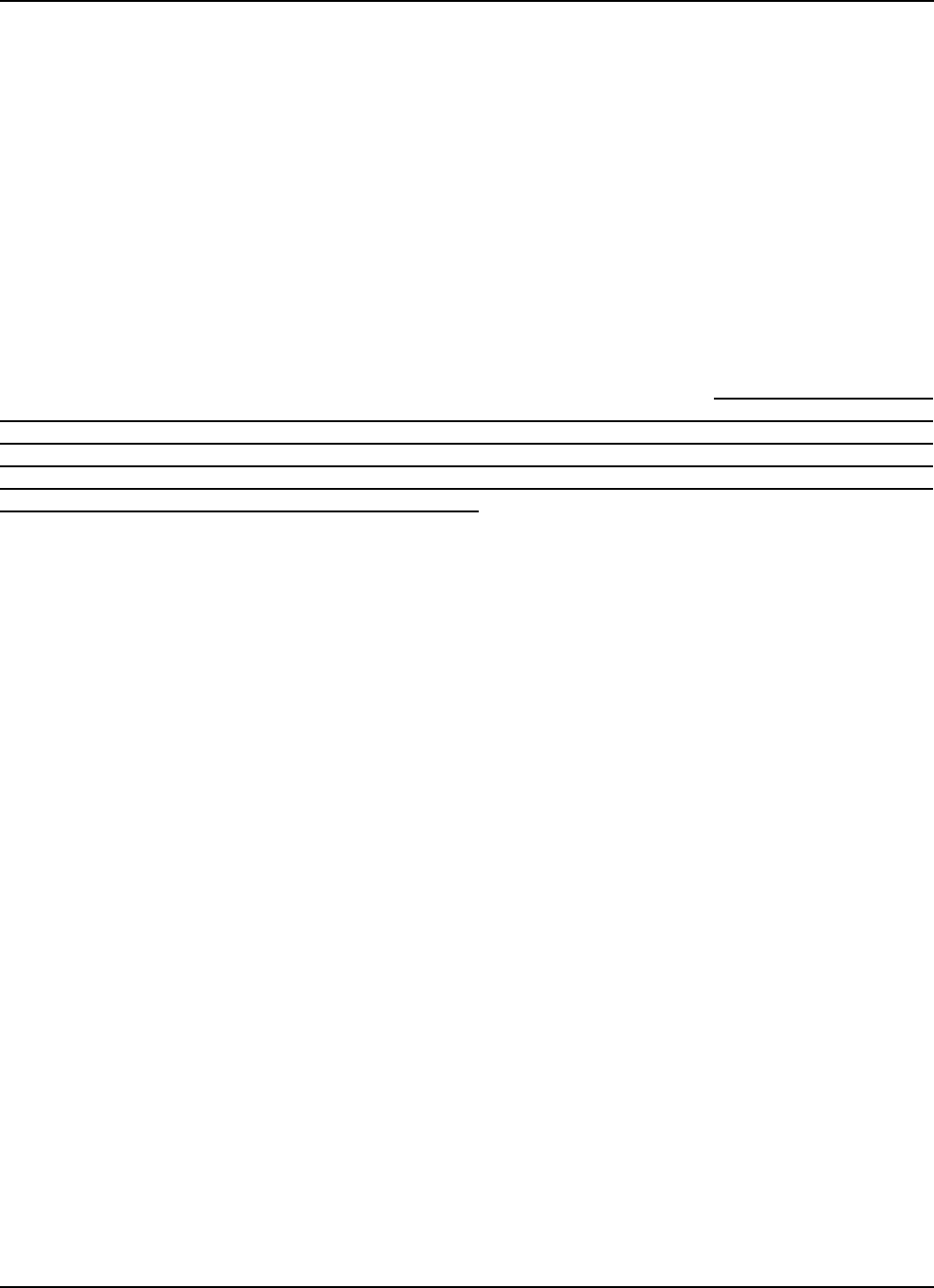
836A 2 kW UHF Translator, Internally Diplexed Set Up and Operation Procedure
- Page 1 of 1 -
Initially the Translator should be turned on with the RF Output at (A11) the Coupler Assembly
terminated into a dummy load of at least 2000 Watts. If a load is not available, check that the
Output of the Coupler Assembly is connected to the Antenna for your System.
Connect the Antenna output to the “F” connector J5 for 75Ω or to the “N” connector J1 for 50Ω,
located on the rear of the VHF/UHF Receiver Tray..
Switch On the Main AC, UHF Exciter, Amplifier #1, Amplifier #2, Amplifier #3 and Amplifier #4 Circuit
Breakers located on the AC Distribution Panel facing the rear of the Cabinet mounted behind the
rear door. On the UHF Exciter Tray, switch the Operate/Standby Switch to Standby and the
Auto/Manual Switch to Manual. Normal operation of the Translator is in Automatic. Automatic
operation uses the Video Input to the UHF Exciter as an Operate/Standby Switch. In Auto, if the
Input Video is lost for approximately 7 seconds, the Translator will automatically revert to Standby
and when the Video Signal is restored, the Translator will quickly return to Operate.
Move the Operate/Standby Switch, located on the UHF Exciter Tray, to Operate. Note the power
supply reading, +26.5 VDC, on the front panel of the UHF Amplifier Trays. Note: If the Translator
does not switch to Operate, when the Operate/Standby Switch is switched to Operate, check that
an External Interlock Plug, with a Jumper wired from Pins 23 to 24, is connected to Jack (J11)
located on the rear of the UHF Exciter or if (A17) the Optional A/V Input & Remote Interface
Assembly is present in your System, the External Interlock Plug, with a Jumper wired from Pins 21
to 22, is connected to Jack (J9) on the Assembly. Observe the front panel Meter reading in the
% Visual Power position on the UHF Exciter Tray, it should read 100%. If needed, readjust the
screwdriver adjust Power pot located on the front panel of the UHF Exciter for 100%. As you are
checking the Power Level, check the Meter Reading in the % Reflected Power Position. If the %
Reflected Power is very high, above 50%, a problem with the Output Coaxial Lines is present and
needs to be checked. A center bullet missing from the 7/8" Rigid Coax Lines or loose bolts on the
connections can cause this problem. Return the Operate/Standby Switch to Standby.
The Gain and Phase controls located on the front panels of the individual UHF Amplifier Trays were
adjusted at the factory to attain 100% Output of the Translator and should not need readjusted.
The front panel readings on the individual UHF Amplifier Trays may not be the same. Refer to the
Test Data Sheet for your Translator to compare the final readings from the Factory with the
readings on each of the Trays after the Set Up. They should be very close to the same. If a
reading is way off, refer to the Phasing and Power Adjustment Procedure for the UHF Amplifier
Trays in the Detailed Alignment Procedure before trying to adjust.
If a dummy load is connected to the Translator, switch the Translator to Standby and switch the
Main AC Circuit Breaker Off. Remove the dummy load and make all connections needed to connect
the Translator to the Antenna for your System. Switch the Main AC Circuit Breaker On and the
Operate/Standby Switch to Operate. Adjust the Output Power screwdriver pot to attain 100%
Output.
If the Translator is already connected to the Antenna, check that the Output is 100%. If needed
adjust the Power screwdriver pot.
If a problem occurred during the Set-Up and Operation Procedure refer to the Detailed Alignment
Procedure of the Translator, which follows, for more information.
This completes the Translator Set-Up and Operation Procedure for the 836A UHF Solid State
Translator. The Translator can now be operated normally.

836A 2 kW UHF Translator, Internally Diplexed Typical Operational Readings
- Page 1 of 1 -
UHF Exciter
ALC = .8 VDC.
% Exciter = The level is as needed to attain 100% output power from the Transmitter.
% Reflected = < 5 %
% Visual Power = 100 %
% Aural Power = 100 %
UHF Amplifier Trays
(A6) (A7)
AGC Voltage = 1 to 2 VDC. AGC Voltage = 1 to 2 VDC.
% Reflected = < 5 % with both Trays operating. % Reflected = < 5 % with both Trays operating.
< 50 % with one Tray operating. < 50 % with one Tray operating.
% Output Forward = The level is as needed % Output Forward = The Level is as needed
to attain 100% Output Power from the Transmitter to attain 100% Output Power from the Transmitter.
Power Supply = +26.5 VDC. Power Supply = +26.5 VDC.
(A8) (A9)
AGC Voltage = 1 to 2 VDC. AGC Voltage = 1 to 2 VDC.
% Reflected = < 5 % with all Trays operating. % Reflected = < 5 % with all Trays
operating. < 25 % with one Tray operating. < 25 % with one Tray
operating.
% Output Forward = The level is as needed to % Output Forward = The Level is as
needed to attain 100% Output Power from the transmitter to attain 100% Output
Power from the Transmitter.
Transmitter.
Power Supply = +26.5 VDC. Power Supply = +26.5 VDC.
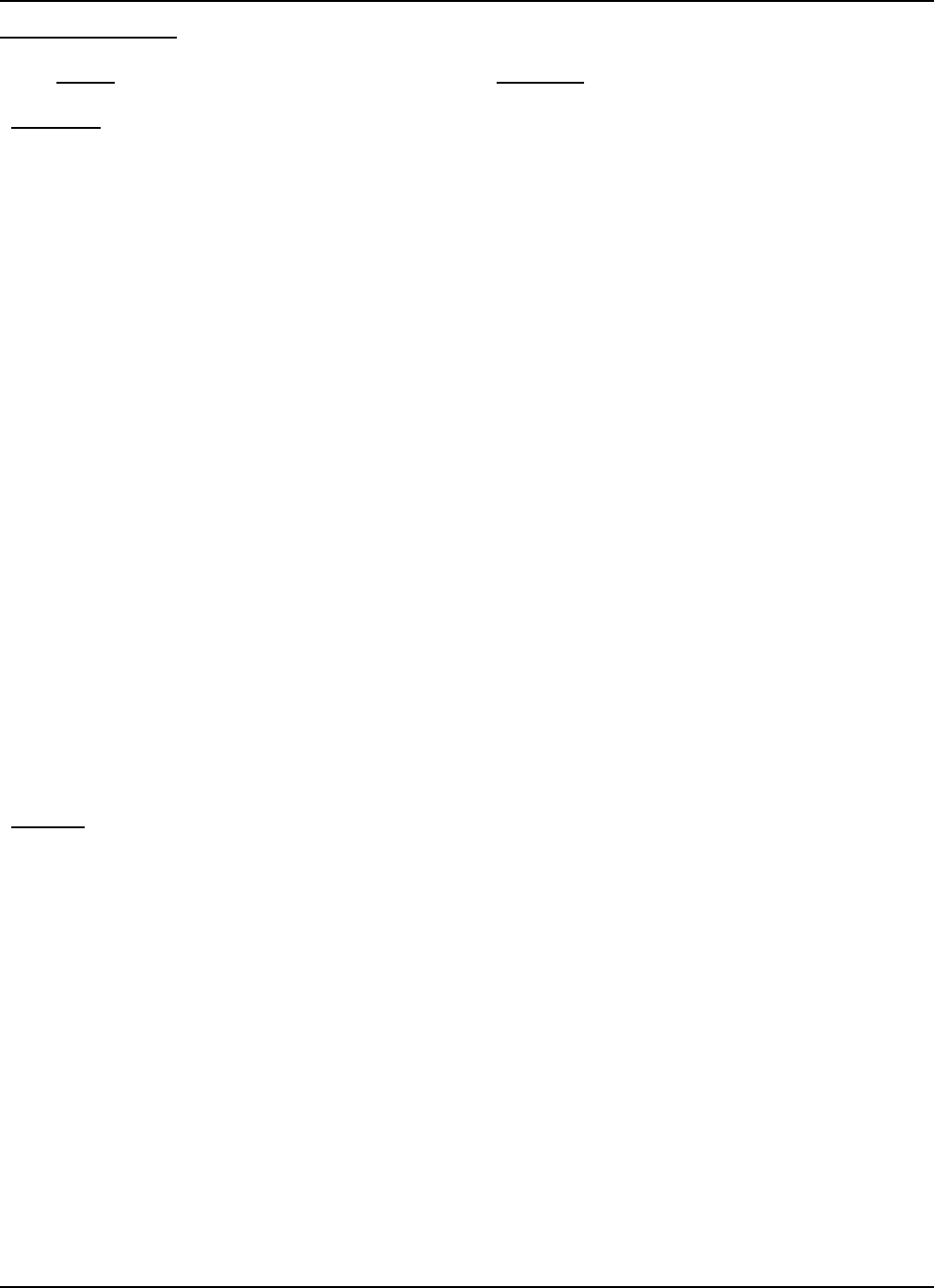
836A 2 kW UHF Translator, Internally Diplexed Meters, Switches, Indicators and Samples
- Page 1 of 4 -
UHF Exciter Tray:
Name Function
“Metering”
Meter (A4-A18) Reads power in terms of a percentage of the calibrated Output
Power level on the upper scale. The Voltage Level is read on
one of the bottom two scales. A full scale reading on the top
scale is 100%, which is equivalent to the full rated 2000 Watts
Peak of Sync Visual. Also reads % Aural Power, % Exciter
Power, % Reflected Power and ALC reading.
Switch (S3), Meter Selects the desired ALC Voltage reading, % Exciter Power, %
Reflected Power, % Visual Power or % Aural Power.
ALC Reads the ALC Voltage Level, .8 VDC, on the 0-10 scale.
(0-10 V)
% Exciter Reads the % Exciter Output Power Level needed to attain
100% Output of the
(0-100) Transmitter on the top scale.
% Aural Power Reads the % Aural Output Power of the Transmitter, 100% =
200 Watts @
(0-100) 10 dB A/V Ratio, on the top scale.
% Visual Power Reads the % Visual Output Power of the Transmitter, 100% =
2000 Watts
(0-100) Pk Sync, on the top scale.
% Reflected Reads the % Reflected Output Power, <5%, on the top scale.
(0-100)
“Control”
Switches
Transmitter (S1) The momentary switch (S1) applies a ground to K1, a latching
Operate/Standby Operate/Standby relay, located on the Transmitter Control
Board. K1 will switch either to Operate or to Standby
depending on which direction S1 is pushed. When switched to
Operate, the low, Enable Commands, are applied to the four
UHF Amplifier Trays. These Enables will turn on the UHF
Amplifier Trays. The opposite occurs when switched to
Standby.
Mode Select (S2) The momentary switch (S2) applies a ground to K2, a latching
Auto/Manual relay, located on the Transmitter Control Board. K2 will switch
the Transmitter to Automatic or Manual depending on which
direction S2 is pushed. In Automatic, the Video Fault Command
from the ALC Board will control the Operation of the
Transmitter. The Transmitter will switch to Standby, after a
slight delay, if the input video is lost and will switch back to
Operate, quickly, when the Video is restored. In Manual, the
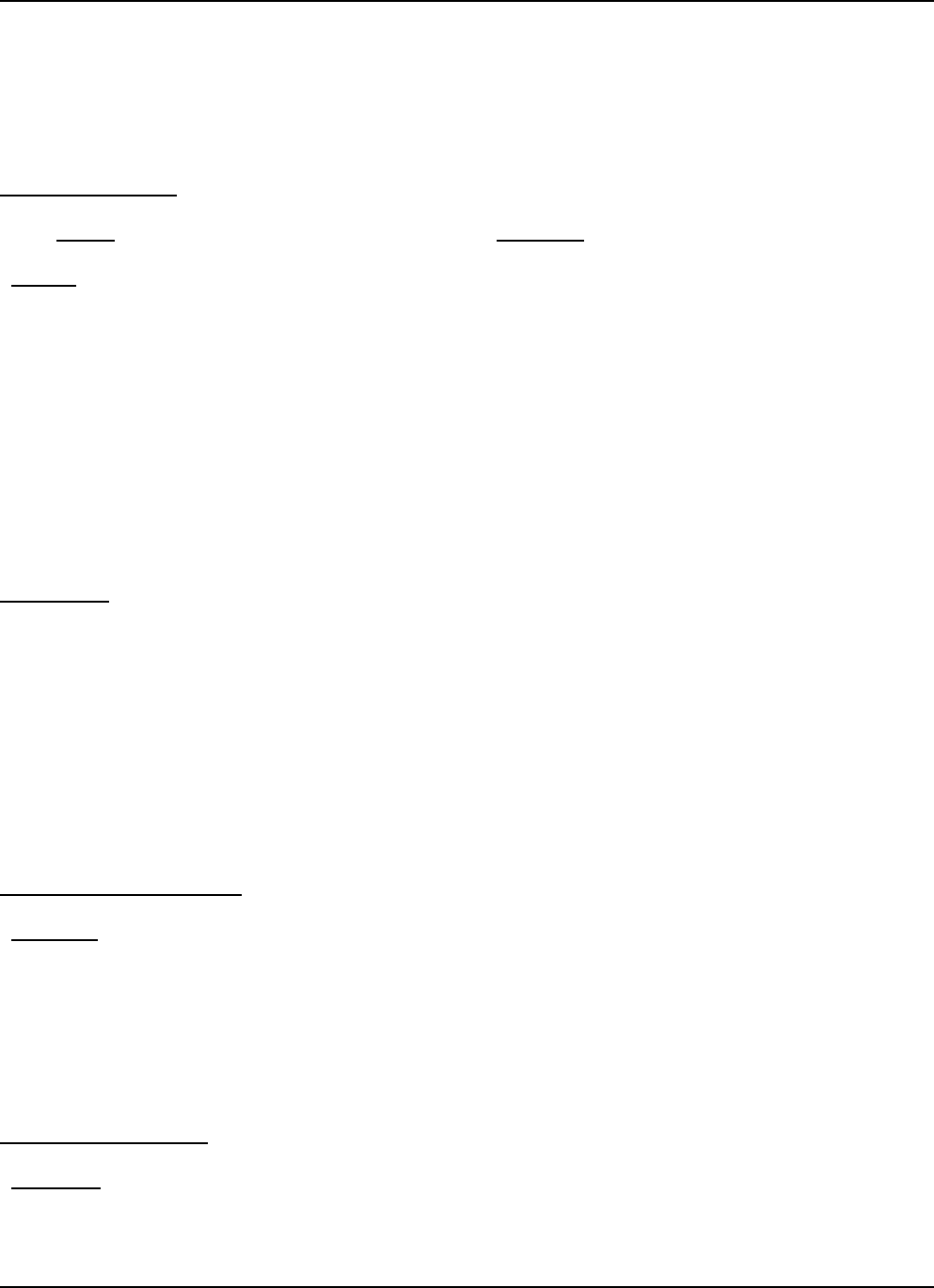
836A 2 kW UHF Translator, Internally Diplexed Meters, Switches, Indicators and Samples
- Page 2 of 4 -
Transmitter is controlled by the Operator using the front panel
Operate/Standby Switch or by remote control.
Power Adjust (R1) The 5 kΩ Pot A20 sets the ALC Level on the ALC Board which
sets the output power of the Transmitter.
UHF Exciter Tray:
Name Function
“Status”
Fault Indicators
Video Loss (DS9 RED) Indicates that the Input Video has been lost to the Translator.
The Fault is generated on the ALC Board located in the UHF
Exciter Tray.
VSWR Cutback (DS7 Amber) Indicates that Reflected Power Level of the Translator has
increased above 20 % which will automatically cutback the
Output Power Level to 20 %. The Fault is generated on the
Transmitter Control Board located in the UHF Exciter Tray.
“Samples”
f(s) A Sample of the Channel Oscillator Output taken from
the Sample Jack of the Channel Oscillator Assembly.
Exciter O/P An Output Power Sample of the Exciter taken from the UHF
Upconverter Board.
Translator O/P A Forward Power Sample of the Translator taken form the
Visual/Aural Metering
Board.
VHF/UHF Receiver Tray
“Samples”
f(IF) Output A Sample of the IF Output taken from the IF Filter/ALC Board.
F(s) Oscillator A Sample of the Channel Oscillator Output taken from the
Sample Jack of the Channel Oscillator Assembly.
UHF Amplifier Trays:
“Metering”
Meter (A6, A7, A8 & A9 - A9) Reads power in terms of a percent of the calibrated power
output value. A full scale reading is 100% which is equivalent
to the full rated 600 Watts Peak of Sync Visual + Aural Output
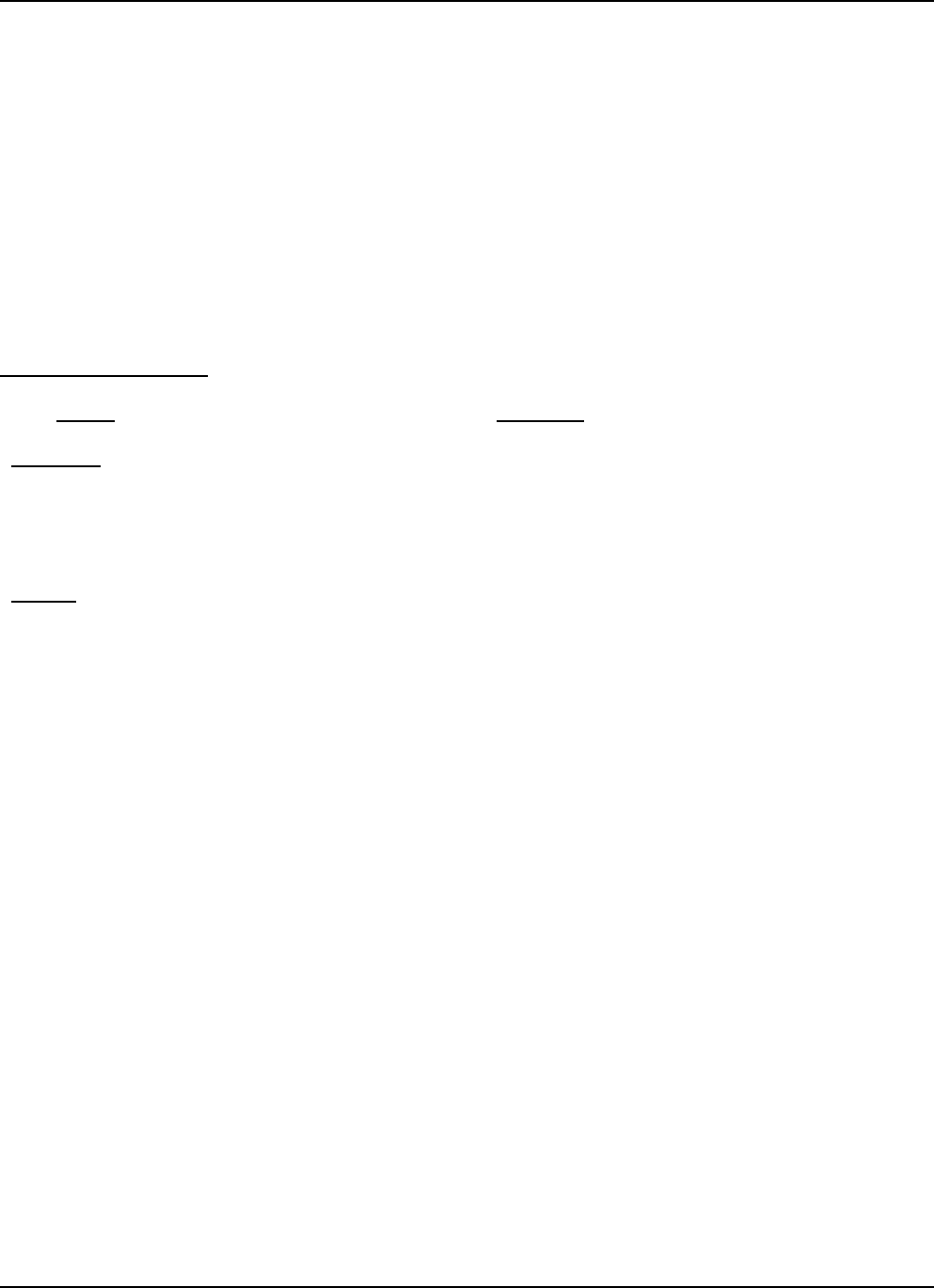
836A 2 kW UHF Translator, Internally Diplexed Meters, Switches, Indicators and Samples
- Page 3 of 4 -
Power. Also reads % Reflected Power, Power Supply Voltage
Levels and AGC Voltage Levels.
Switch (S2), Meter Selects the desired % Power or the Voltage reading.
% Output Pwr Reads the % Output Power of the Tray, 100% = 600 Watts
Peak of Sync Visual + Aural, on top scale.
% Refl (Reflected) Reads the % Reflected Output Power of the Tray, <20% with
all Amplifier Trays operating A6, A7, A8 & A9, as measured on
top scale.
Power Supply Reads the Power Supply Voltage, +26.5 VDC, on the middle
scale.
UHF Amplifier Trays:
Name Function
“Metering” - Continued
AGC Voltage Reads the AGC Voltage Level, +1 VDC to +3 VDC, on bottom
scale.
“Status”
Indicators
Enable (DS4 Green) Indicates that an Enable, Operate Command, is applied to the
UHF Amplifier Tray from the selected UHF Exciter Tray.
Overdrive (DS2 Red) Indicates that the level of the drive is too high. The protection
circuit will limit the drive to the set threshold. The Fault is
generated on the Amplifier Control Board.
VSWR Cutback (DS1 Red) Indicates that Reflected Power Level of the Tray has increased
above 50% which will automatically cutback the Output Power
Level to 20 %. The Fault is generated on the Amplifier Control
Board.
Overtemp (DS3 Red) Indicates that the temperature of (A5-A6-A3 & A5-A6-A4) one
or both of two Thermal Switches mounted on the heatsink
assembly for the output amplifiers is above 175 degrees F.
When this Fault occurs the Enable to the Switching Power
Supply in the effected Amplifier Tray is removed immediately
and it will shut down.
Input Fault (DS5 Red) Indicates that the Input RF Level to the Amplifier Trays
dropped below the 0 dBm Range.
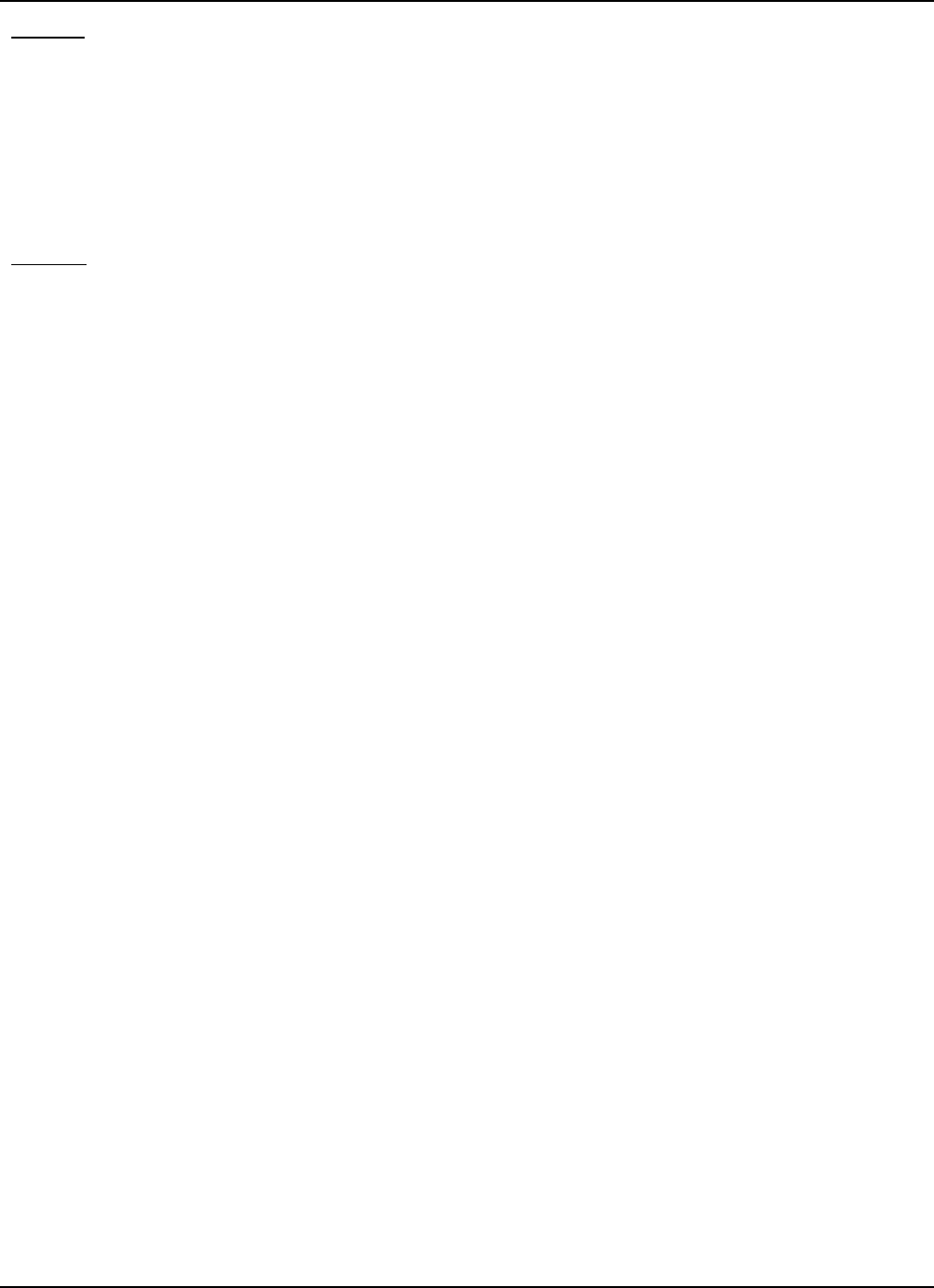
836A 2 kW UHF Translator, Internally Diplexed Meters, Switches, Indicators and Samples
- Page 4 of 4 -
“Control”
Adjustments
Phase (A10-R5) Adjusts the Phase of the RF Output approximately 70°.
Gain (A11-R6) Adjust the gain of the RF Output when the Amplifier control
Board is in the AGC Mode.
“Sample”
Module O/P (0 dBm) A Sample of the Combined Output of the four Dual Stage
Amplifier Boards taken from the Dual Peak Detector Board.

836A 2 kW UHF Translator, Internally Diplexed Detailed Alignment Procedure
- Page 1 of 7 -
This Translator was aligned at the factory and should require no additional alignment to achieve
normal operation.
Check that the RF Output at J2 of (A16) the Coupler of the Translator is terminated into a dummy
load of at least 2000 Watts. Refer to the Test Data Sheet for your Translator and compare the
final readings from the Factory with the readings on each of the Trays while doing the alignment.
They should be very close to the same. If a reading is way off, the problem is likely to be in that
Tray.
Switch On the Main AC and the UHF Exciter Circuit Breakers located on the AC Distribution Panel
mounted behind the rear Cabinet door.
(A3) VHF/UHF Receiver Tray (1265-1100)
Connect a UHF Input (-61 dBm to -16 dBm), with a Multiburst Test signal applied, that is at the On
Channel Frequency to Jack J5, "F" type connector for 75Ω or Jack J1, "N" type connector for 50Ω
located on the Receiver Tray. Check that the On/Off Circuit Breaker, located on the rear of the
Receiver Tray, is On. If the Optional Remote Preamplifier is purchased, the Fuse F1 located in the
Receiver Tray must be removed to eliminate the +12 VDC from the input to the Receiver Tray to
prevent damage to the Test equipment. Check the Front Panel Sample Jack (J6) with a Frequency
Counter. The signal should be at the needed frequency, check the top of the Channel Oscillator
Assembly for the actual frequency, to produce the IF Outputs.
(A4) UHF Exciter Tray (1300-1020)
The IF Section of the UHF Exciter Tray includes adjustments for automatic level control (ALC),
linearity (amplitude predistortion) and phase (phase change vs. level) predistortion for correction
of the nonlinearities of the RF Amplifier Trays. The Upconverter Section also includes adjustments
of the local oscillator chain tuning and also the local oscillator center frequency tuning. Both of
these were completed at the factory and should not require adjustment at this time.
Move the Operate/Standby Switch located on the UHF Exciter Tray to Standby. The set up of the
RF Output, includes adjustment of the drive level to the four UHF Amplifier Trays, the adjustment
of the Linearity and Phase Predistortion which compensate for any nonlinear response of the
Amplifier Trays and also the gain and phasing adjustments of the four UHF Amplifier Trays.
Verify that all Red LEDs located on the ALC Board are extinguished. The following list details the
meaning of each LED when illuminated.
DS1 (Input Fault) Indicates abnormally low or no IF is present at the Input of the ALC Board.
DS2 (ALC Fault) Indicates that the ALC circuit is unable to maintain the signal level requested by
the ALC reference. Normally this is due to excessive attenuation in the linearity signal path, the IF
Phase corrector signal path or that Jumper W3 on J6 is in the Manual ALC Gain position.
DS3 (Video Loss) Indicates a loss of Video at the Input of the ALC Board.
DS4 (Mute) Indicates a Visual Mute Command is present. Not used in this configuration.
DS5 (Modulator Enable) Indicates Modulator IF Output is selected. Will be Off if the output of the
Receiver Tray is selected.
The ALC is Muted when the Translator is in Standby. To monitor the ALC, turn Off the front panel
On/Off circuit breaker located on the Amplifier Trays and switch the Translator to Operate. Adjust

836A 2 kW UHF Translator, Internally Diplexed Detailed Alignment Procedure
- Page 2 of 7 -
the Power Adjust Gain Pot, located on the Front Panel of the UHF Exciter Tray, to obtain +0.8 VDC
on the Front Panel Meter in the ALC Position. On the ALC Board (1265-1305), move the Jumper
W3 on J6 to the Manual Position, between Pins 2 & 3, and adjust R87 on the ALC Board for +0.8
VDC on the Front Panel Meter in the ALC Position. Move the Jumper W3 back to Auto, between
Pins 1 & 2, which is the normal operating position. The detected IF signal level at J19-2 of the
ALC Board is connected to the Transmitter Control Board that distributes the level to the Four UHF
Amplifier Trays where it is used as a reference for the automatic gain control (AGC) in each
Amplifier Tray.
(A6, A7, A8 & A9) UHF Amplifier Trays (1294-1112 Low Band, 1294-1113 Mid Band, or
1294-1114 High Band)
Check that the output power of the Translator is 100 %, if it is not, adjust the Power screwdriver
Adjust Pot located on the front panel of the UHF Exciter Tray as needed to achieve 100%.
When testing one of the UHF Amplifier Trays the other circuit breakers, located on the AC
Distribution Panel, should be turned Off. The Amplifier 1 Circuit Breaker applies power to the Top
left UHF Amplifier Tray, the Amplifier 2 Circuit Breaker applies power to the bottom left UHF
Amplifier Tray, the Amplifier 3 Circuit Breaker applies power to the bottom left UHF Amplifier Tray
and the Amplifier 4 Circuit Breaker applies power to the bottom right UHF Amplifier Tray. The UHF
Amplifier Trays should be turned on into a dummy load of at least 600 Watts to verify that the
Tray is functioning. Preset the AGC Switch on (A8) the Amplifier Control Board (1265-1414) to the
AGC On position. The four UHF Amplifier Trays are set up in pairs, the top two A6 with A7 and the
bottom two A8 with A9. Switch On the Amplifier 1 Circuit Breaker, located on the AC Distribution
Panel. Switch to Operate the Translator Operate/Standby Switch, located on the UHF Exciter, and
observe the power supply metering position on the UHF Amplifier Tray. It should read +26.5 VDC
when the Tray is switch On and the Translator is in Operate.
Switch the Tray to the % Output Power Meter Position and adjust the front panel Gain pot located
on that Amplifier Tray to 100% on the Meter, then back off the Gain Pot to the reading as written
on the Test Data Sheet for your Translator. Repeat for the Amplifier 2 Tray of the pair. Switch
the Translator to Standby and reconnect the UHF Amplifier Trays to the (A10) UHF Tee Assembly.
Repeat the above procedure for Amplifier 3 and Amplifier 4. After the setup of all four Amplifier
Trays, switch the Translator to Operate and adjust the Phase Controls on each of the Amplifier
Trays to give maximum Output Power on the Front Panel of the UHF Exciter. The Output Power
reading on the front panel of the UHF Exciter should be 100%, if it is not, adjust the Power
screwdriver Adjust Pot located on the front panel of the UHF Exciter Tray as needed to achieve
the 100% Output.
Switch the Input Test source to select a NTSC 3.58 MHz Modulated Staircase or Ramp Test
waveform and set up the station demodulator and monitoring equipment to monitor the differential
gain and differential phase of the RF Output signal.
If a synchronous demodulator having a quadrature video output is available, it can be used with an
X-Y Oscilloscope to display incidental carrier phase modulation (ICPM). As shipped, the Exciter
was preset to include linearity (gain vs. level) and incidental phase (carrier phase vs. level)
predistortion. The predistortion was adjusted to approximately compensate the corresponding
non-linear distortions of the Amplifier which is driven to place the Sync Level near saturation.
Move the Jumper W1 on J4 on the ALC Board to the Enable Position. Refer to the Test Data Sheet
for your Translator for the final test readings on each Amplifier Tray. Adjust the Phase Pot located
on each UHF Amplifier Tray to obtain maximum % Visual Output Power. Adjust each of the Gain
Pots, on the UHF Amplifier Trays, equally, as needed to obtain 100% Visual Output Power on the
Front Panel Meter of the UHF Exciter.

836A 2 kW UHF Translator, Internally Diplexed Detailed Alignment Procedure
- Page 3 of 7 -
Linearity Corrector Adjustment
The IF linearity correction function consists of three non-linear cascaded stages, each having
adjustable magnitude and threshold or cut-in points located on the ALC Board. The threshold
adjustment determines at what IF signal level the corresponding corrector stage begins to increase
gain. The magnitude adjustment determines the amount of gain change for the part of the signal
which exceeds the corresponding threshold point. Refer to the UHF Exciter Tray Assembly Drawing
(1265-5300), or the Assembly Drawing for (A8) ALC Board (1265-5305), to locate the adjustments
for the first through third linearity corrector stages. Because the stages are cascaded, the order
of correction is important. The first stage should cut-in near white level, with the cut-in point of
the next stage toward black and with the last stage primarily stretching sync.
To adjust the linearity correctors from scratch. Ensure that the Translator is operating at full
power with the desired A/V Ratio. Check that the Jumper W1 on J4 on the ALC Board is Enabled,
between Pins 1 & 2. Check that the ALC Voltage is set to +0.8 VDC as monitored on the Front
Panel Meter in the ALC Position.
Insert a modulated ramp video test signal into the Translator. Demodulate the output signal of the
Translator and observe the waveform on a Waveform Monitor while also looking at the signal on a
Spectrum Analyzer. On the IF ALC Board (1265-1306), preset the Pots R34, R37 & R40 (Threshold)
full CCW, and the Magnitude Adjustments R13, R18 & R23 full CW. On the IF Phase Corrector
Board (1227-1250), preset the Pots R7, R15, R23 & R35 full CW, and R3, R11, R19 & R31 full CCW.
Linearity Corrector Adjustment - Continued
Set the Waveform Monitor to Differential Step Filter and the Volts/Division scale to .1V. Center
the display around Blanking.
Gradually adjust pots R3, R11 and R19 Clockwise on the IF Phase Corrector Board as needed to
minimize the observed thickness of the intermod as seen on the display.
Adjust the pots R34, R37 and R40 Clockwise on the IF ALC Board needed to give correction at
Sync or at low luminance levels, which are viewed at the rightmost edge of the Waveform Monitor.
The intermod beat products between the Color Burst and the Aural Carrier at 920 kHz above Visual
Carrier should also be observed on the Spectrum Analyzer while performing the preceding
adjustments. The frequency will vary for PAL Systems. When the adjustments are performed
properly, the intermod products on the Spectrum Analyzer should be at least -52 dB down, with a
Red Field input, from peak visual carrier and the Intermod Distortion as displayed on the Waveform
Monitor should be no more than 1 IRE. The pot R31 on the IF Phase Corrector Board is used for
any extra Intermod correction that may be needed.
It should be noted that any adjustment of the above pots affects other visual parameters and
some slight adjustments of all the pots may be needed to meet all specifications simultaneously.
If the Translator is being driven very hard, it may not be possible to get enough Sync Stretch
while maintaining a flat differential gain. In this case, some Video Sync Stretch may be used from
the Sync Tip Clamp/Modulator Board. The Sync Stretch adjustment is R48 located on the Sync
Tip Clamp/Modulator Board. Switch the Translator to Standby.
Phase and Gain Adjustment of the UHF Amplifier Trays

836A 2 kW UHF Translator, Internally Diplexed Detailed Alignment Procedure
- Page 4 of 7 -
The following procedure was completed at the factory and should only be followed if one of the
UHF Amplifier Trays is replaced.
Preset the Phase and Gain potentiometer located on each UHF Amplifier Tray Full CCW. Switch the
Translator to Operate and adjust the Gain Pot on each Tray for 25% Output Power. Adjust the
Phase Control CW on the Left UHF Amplifier Tray. If the % Visual Output Power goes UP, continue
to adjust until either the Peak is reached or the End of Travel is reached. If the % Output Power
goes Down, Reset the Phase Control on the UHF Amplifier Tray Fully CCW and repeat the above
procedure with the Phase Control of the other Amplifier Tray.
If the End of Travel is reached on the Phase Adjust, Reset the Phase Control CCW and add a 2"
length of Cable to the output of the (A5) Splitter Module which connects to the effected UHF
Amplifier Tray at J1. Readjust the Phase of that Tray until a Peak is reached or until End of Travel
is achieved. If End of Travel is reached, repeat the above procedure replacing the 2" length cable
with a 4" length of cable. Once a Peak is reached, move the Phase Control, that is Full CCW, Up 2
Turns and re-peak using the Phase Control located on the other Tray. This allows both Trays to
have some range of adjustment.
Adjust the Gain of both UHF Amplifier Trays for 90% Tray Output Power. Readjust each Phase
Control to Peak the Combined Output, the Phase should only have been effected slightly. There
should be a definite Peak that is achieved while adjusting the Phase of each Tray though it may
take a few Turns to notice a change. Raise or Lower the Output Power of each Tray to achieve
100% Output Power. The Output Power of each Tray should be 90% - 100%.
Calibration of the Forward Output Power Level of the Translator
Note: - Perform the following only if the power calibration is suspect.
Switch the Translator to Standby and preset R51, Aural Null pot, located on the Visual/Aural
Metering Board (1265-1309), full CCW. Adjust R48, the Null Offset pot, located on the Visual/Aural
Metering Board, for 0% Visual Output. Do the following adjustments with no Aural present, by
removing the Aural from the RF Input Test Signal. Connect a Sync and Black Test Signal to the
Input of the UHF Exciter Tray. Switch the Translator to Operate.
Calibration of the Forward Output Power Level of the Translator.- Continued
Next Set the Translator up for the appropriate Average Output Power Level. (Sync + Black 0 IRE
Setup Wattmeter = 1190 Watts). (Sync + Black 7.5 IRE Setup Wattmeter = 1090 Watts).
Note: Must have 40 IRE Units of Sync. Adjust R28, Visual Calibration, located on (A19) the
Visual/Aural Metering Board (1265-1309) for 100% on the front panel meter in the % Visual Output
Position.
With the Spectrum Analyzer set to Zero Span Mode, obtain a peak reference on the screen.
Reinsert the Aural to the RF input test Signal. While in the Visual Output Power position, adjust L3
for minimum visual power reading. Turn the power adjust pot on the front panel until the original
peak reference level is attained. Peak L1 and C8 for maximum Aural Power reading, then adjust
R20 also for 100% Aural Power reading. Then switch to Visual Output Power position and adjust
R51 for 100% Visual Power.
Calibration of the Reflected Output Level of the Translator
Turn the Power Adjust Pot to 20% on the Meter in the Visual Power position, check that the
Jumper is in Manual on the UHF Upconverter Board (1265-1310). Unterminate the Translator and
adjust R39 on the Visual/Aural Metering Board (1265-1309) for a 20% reading in the Reflected

836A 2 kW UHF Translator, Internally Diplexed Detailed Alignment Procedure
- Page 5 of 7 -
Power position. At this 20% Reference Power reading, the VSWR LED mounted on the front panel
of the Exciter should be illuminated. If not adjust R22 on the Transmitter Control Board until the
VSWR LED just turns On. Turn the Power Adjust pot slightly CCW and the LED should go out, turn
the pot CW until the LED just turns On. The Reflected Output Power is now calibrated. Switch
the Translator to Standby. Re-terminate the Translator. Switch the Translator to Operate and
adjust the front panel power pot for 100% Visual Power reading.
IF Phase Corrector Adjustment
As shipped, the Exciter was preset to include linearity (gain vs. level) and phase (phase vs. level)
predistortion. The predistortion was adjusted to approximately compensate the corresponding
non-linear distortions of the Amplifier Trays and should need no additional adjustment.
Locate (A9) the IF Phase Corrector Board (1227-1250) mounted in the UHF Exciter. The Amplitude
Correction portion of the Board is not utilized in this configuration, therefore the Jumper W3 on J10
should be in the Disable Position, to +6.8 VDC, and R35 & R31 should be full CCW. R68 is the
Range Adjustment and should be set in the Middle. The Phase Correction Enable/Disable Jumper
W2 on J9 should be in the Enable Position, to Ground. Switch the Input Video Test source to
select a NTSC 3.58 MHz Modulated Staircase or Ramp Test waveform and set up the station
demodulator and monitoring equipment to monitor the Differential Phase or Intermod Products of
the RF Output signal. There are three corrector stages, located on the IF Phase Corrector Board,
each with a Magnitude and a Threshold Adjustment which are adjusted as needed to correct for
any Differential Phase or Intermod problems. Adjust R3 Threshold, for the cut in point of the
correction and R7 Magnitude, for the amount of the correction as needed.
The jumper W1 on J8 is set to give the desired polarity of the correction shaped by the Threshold
R11 and Magnitude R15 adjustments. After setting the polarity, adjust R11 Threshold, for the cut
in point of the correction and R15 Magnitude, for the amount of the correction as needed. Finally,
adjust R19 Threshold, for the cut in point of the correction and R23 Magnitude, for the amount of
the correction as needed. Note: Adjusting these pots changes all Visual parameters and should be
used cautiously.
(A10 & A11) UHF High Power Tees
The inputs to the (A10) UHF Tee are the outputs of the (A6 & A7) UHF Amplifier Trays and the
inputs to the (A11) UHF Tee are the outputs of the (A8 & A9) UHF Amplifier Trays. The inputs to
the UHF Tees are 50 ohm impedances to match the output impedance of the UHF Amplifier Trays.
The two inputs to each of the UHF Tees are combined and then sent through a piece of
transmission line 1/4 of a wavelength long to transform the output impedance of the Tees to 50
ohms. The outputs of the (A10 & A11) UHF Tee are then sent to (A12) a Hybrid Combiner which
combines the two inputs. The output of the Hybrid is connected to (A13) a Bandpass Filter.
The Bandpass Filter and (Optional) Trap Filter are factory swept and should not be tuned
without the proper equipment. Do not attempt to tune the filters without a sweep
generator and preferably a network analyzer. If you think tuning is needed consult Axcera
Field Support Department before beginning.
(A13) Bandpass Filter
The input to this filter is output of the Hybrid Combiner that is the combined output of the UHF
Amplifier Trays. The filter is made of aluminum waveguide and has five resonant cavities. The
filter has five bolts for tuning adjustments, three located in the middle on left and two on the right,
and four or six rods, depending upon the channel, for coupling adjustments between the sections,
located on the front of the Bandpass Filter. The Bandpass Filter also utilizes two integral traps at
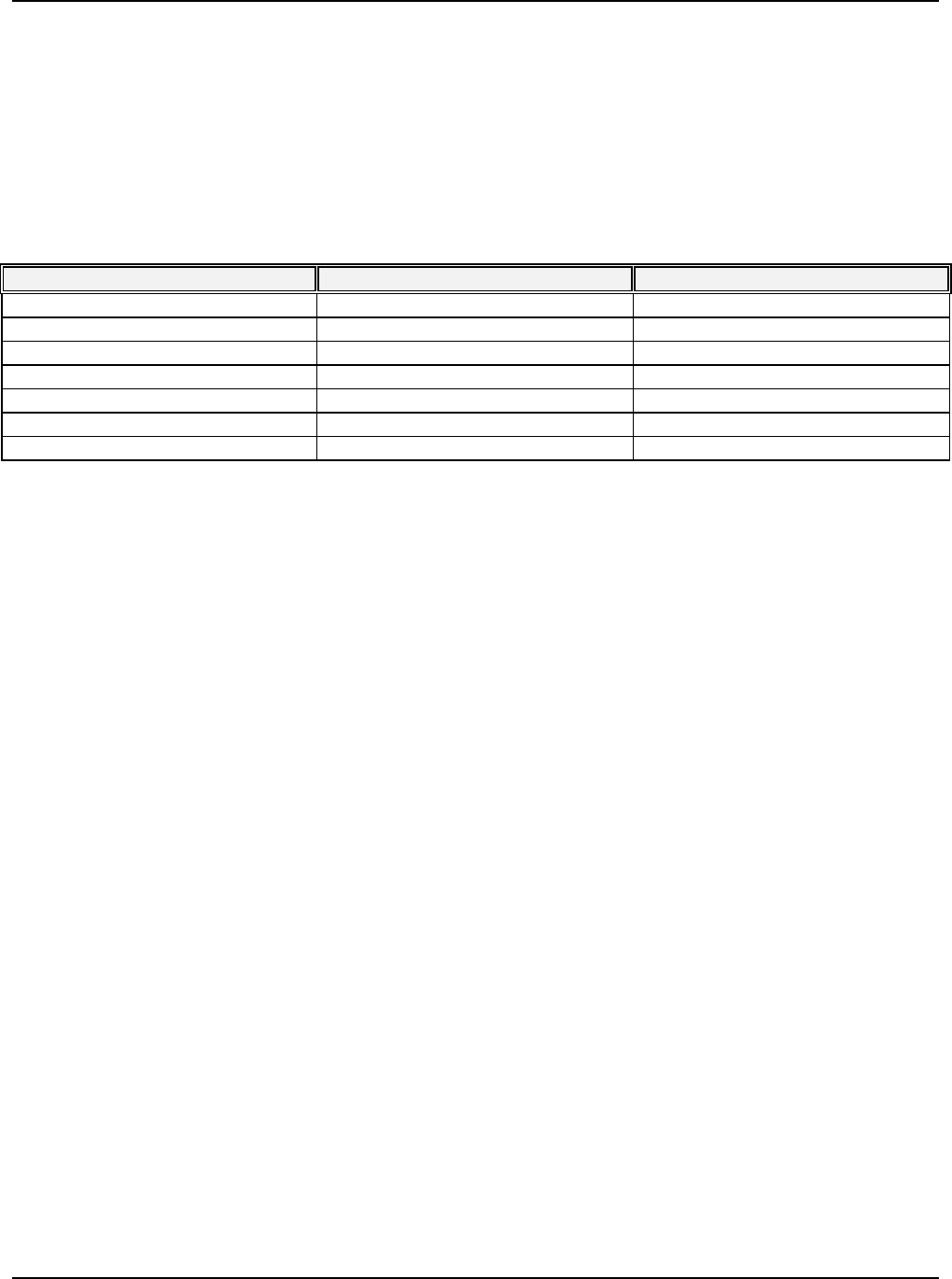
836A 2 kW UHF Translator, Internally Diplexed Detailed Alignment Procedure
- Page 6 of 7 -
-4.5 MHz and +9 MHz from FV at the top and bottom respectively of the left hand side of the
Bandpass Filter, looking from the rear of the Cabinet. Refer to the Bandpass Filter Drawing for the
location of the adjustments.
To tune the filter, connect a sweep signal to the input of the filter and adjust the five tuning bolts
for a 6 MHz bandwidth and a flat frequency response across the desired band. Note: The
Bandpass Ripple should be ≤0.25 dB. The 6 MHz Band should also have a minimum of 20 dB return
loss across the pass band.
Refer to the Table below for typical values.
Frequency Insertion Loss (dB) Return Loss (dB)
FV-4.5 ≥35
FV-0.5 ≥20
FV≤0.6 ≥20
Fa≤0.6 ≥20
FV+8.08 ≥15
FV-9 ≥30
2FV≥30
(Optional) (A14) One or Two Section Trap Filter
The Trap Sections have been factory tuned and should not need major adjustments. The Trap
Filter is Optional and may not be part of your System. The input to the One or Two Section Trap
Filter is the output of the Coupler Assembly. The Trap Filter is comprised of 3-1/8" EIA standard
transmission line sections connected to the main transmission line. The transmission line assembly
consists of 7/8" EIA standard rigid coaxial components.
The Traps on the output Trap Filter are labeled with their Center Frequency relative to the
Frequency of the Carrier. (For Example: The Traps labeled -4.5 MHz are tuned for a Center
Frequency of 4.5 MHz Lower than the Frequency of the Visual Carrier.)
The Trap Sections are Reflective Notches, adjustable across the entire UHF Frequency Band. The
electrical length of the Outer Sleeve and the Center Rod of the Notch can be adjusted to Tune the
Notch Frequency. The Depth of the Notch is set by the gap between the Center Conductor of the
Trap Section and the Center Conductor of the Main Line. Tight Coupling makes a Deep Notch,
while Loose Coupling makes a Shallow Notch.
Fine Tuning, of the Notches Center Frequency can be accomplished with the Tuning Bolts located
on the side of the Filter Section. Loosen the nut locking the Bolt in place and adjust the Bolt to
change the Frequency of the Notch. Monitor the output of the Translator with a Spectrum
Analyzer and Null the Distortion Product with the Bolt. Red Field is a good Video Test Signal to use
to see the +8.08 MHz Product. Tighten the nut when the tuning is completed. Hold the bolt in
place with a screwdriver as the nut is tightened to prevent it from slipping.
Major Tuning, such as changing the Notch Depth or moving the Notch Frequency more than 1
MHz, the Outer Conductor and the Center Conductor of the Trap Section must both be moved.
This requires an RF Sweep Generator to accomplish. Apply the Sweep signal to the Input of the
Trap Filter and monitor the Output. Loosen the Clamp holding the Outer Conductor in place and
make the length longer to Lower the frequency of the Notch or shorter to Raise the frequency of
the Notch. Loosen the Center Conductor with an Allen Wrench and move it Deeper for a Lower
Frequency Notch or out for a Higher Frequency Notch. These adjustments must both be made to
change the Notch Frequency. Moving only the Center Conductor or the Outer Conductor will
effect the Notch Depth in addition to the Center Frequency. The variable that is being adjusted

836A 2 kW UHF Translator, Internally Diplexed Detailed Alignment Procedure
- Page 7 of 7 -
with this procedure is the length of the Center Conductor inside the Trap Filter. The gap between
the Trap and the Main Line should not be changed. Moving only the Inner or the Outer Conductors
by itself will effect the Gap and the Notch depth.
To effect the Notch Depth Only, both sections will have to be moved. The Notch Depth is
controlled by the Gap between the Center Conductor and the Trap Section. This Gap also has an
effect on the Center Frequency. To Deepen the Notch, Shorten the Outer Conductor and pull the
Center Conductor Out until the Notch is back in the same place. Move the Sections in the
opposite direction to make a Shallow Notch. Note: The Trap Filter is typically adjusted for a notch
depth of 10 dB.
The Effects of tuning the Output Trap Filter
Lengthening Outer Conductor Only ..................................Notch Frequency Up, Shallower Notch.
Shortening Outer Conductor Only ....................................Notch Frequency Down, Deeper Notch.
Inserting Inner Conductor Deeper....................................Notch Frequency Down, Deeper Notch.
Inserting Less Inner Conductor .......................................Notch Frequency Up, Shallower Notch.
Tuning Bolt In..................................................................................Notch Frequency Down.
Tuning Bolt Out................................................................................... Notch Frequency Up.
Moving both Inner and Outer Conductors
to keep the Same Gap inside ............................ Center Frequency Moves Notch Stays the Same.
After tuning has been completed, tighten the Clamp and the Allen Screws that hold the
Conductors. Use the Fine Tuning Bolts to bring the Frequency In. The Final Tuning Adjustments
should be completed with the Translator driving the Output Trap Filter for at least one hour to
allow for warm-up drift.
This completes the Detailed Alignment Procedure for the Translator. If a problem occurred during
the alignment, refer to the Detailed Alignment Procedure for that Tray for more information.
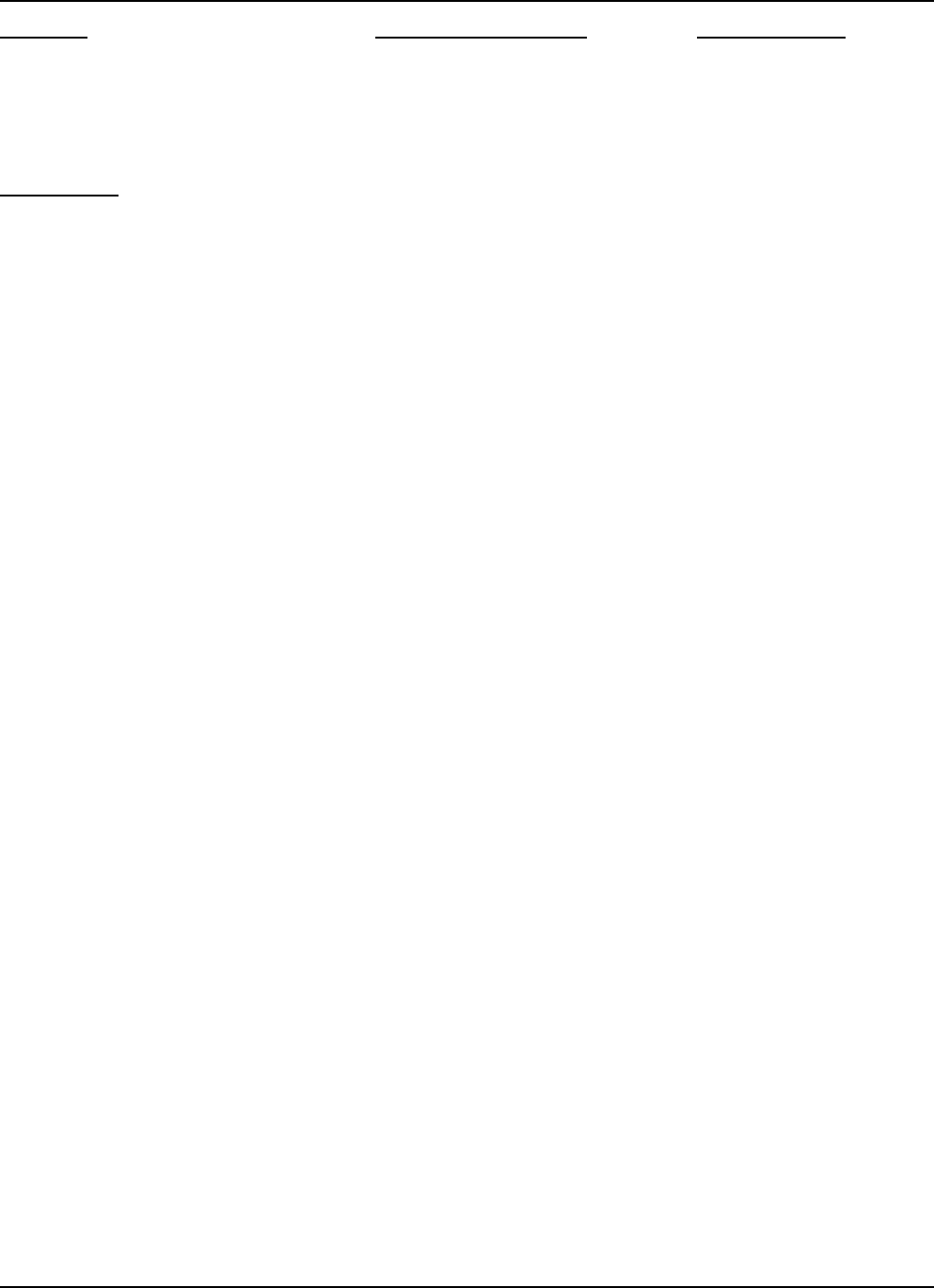
836A 2 kW UHF Translator, Internally Diplexed Remote Control Interface Connections
Function Remote Jack/Pin No. Interface Type
- Page 1 of 4 -
The Remote Connections, as listed below, are made if the Optional (A17) A/V Input & Remote
Interface Assembly (1276-1008) is not present in your System. Refer to the Interconnect
Drawing (1276-8000) for the proper Pin Remote Connections.
UHF Exciter
Translator Enable Interlock J11-24 J11-24 & 23 must be jumpered
Translator Enable Interlock Rtn.J11-23 together for Normal Operation.
(1176-1038) Jumper Jack is used.
Remote Control Commands:
Translator Standby (Disable) J11-22 Contact Closure
Translator Standby/Operate Rtn.J11-21
Translator Operate (Enable) J11-20 Contact Closure
Translator Manual J11-9 Contact Closure
Translator Auto/Manual Rtn.J11-36
Translator Auto J11-8 Contact Closure
Power Level Raise (Optional) J10-11 Contact Closure
Pwr Lvl Raise/Lower Rtn (Optional) J10-13
Power Level Lower (Optional) J10-12 Contact Closure
Modulator Select (Optional) J11-10 Contact Closure
Modulator Select Rtn (Optional) J11-28
Remote Status Indications:
Translator Operate (Enable) Ind. J10-3 50mA Max. Current Sink
Operate/Standby Ind. Return J10-16
Translator Standby (Disable) Ind. J10-4 50mA Max. Current Sink
Translator Auto Indicator J11-7 50mA Max. Current Sink
Auto/Manual Indicator Return J11-32
Translator Manual Indicator J11-650mA Max. Current Sink
VSWR Cutback Indicator J11-37 50mA Max. Current Sink
VSWR Cutback Indicator Return J11-35
Video Loss (Fault) Indicator J11-25 50mA Max. Current Sink
Video Loss (Fault) Ind. Rtn.J11-31
Receiver Fault Indicator J11-12 50mA Max. Current Sink
Visual Output Power J11-26 1V full scale at 1kW
Visual Output Power Rtn J11-29 source resistance
Aural Output Power J11-27 1V full scale at 1kW
Aural Output Power Rtn J11-30 source resistance
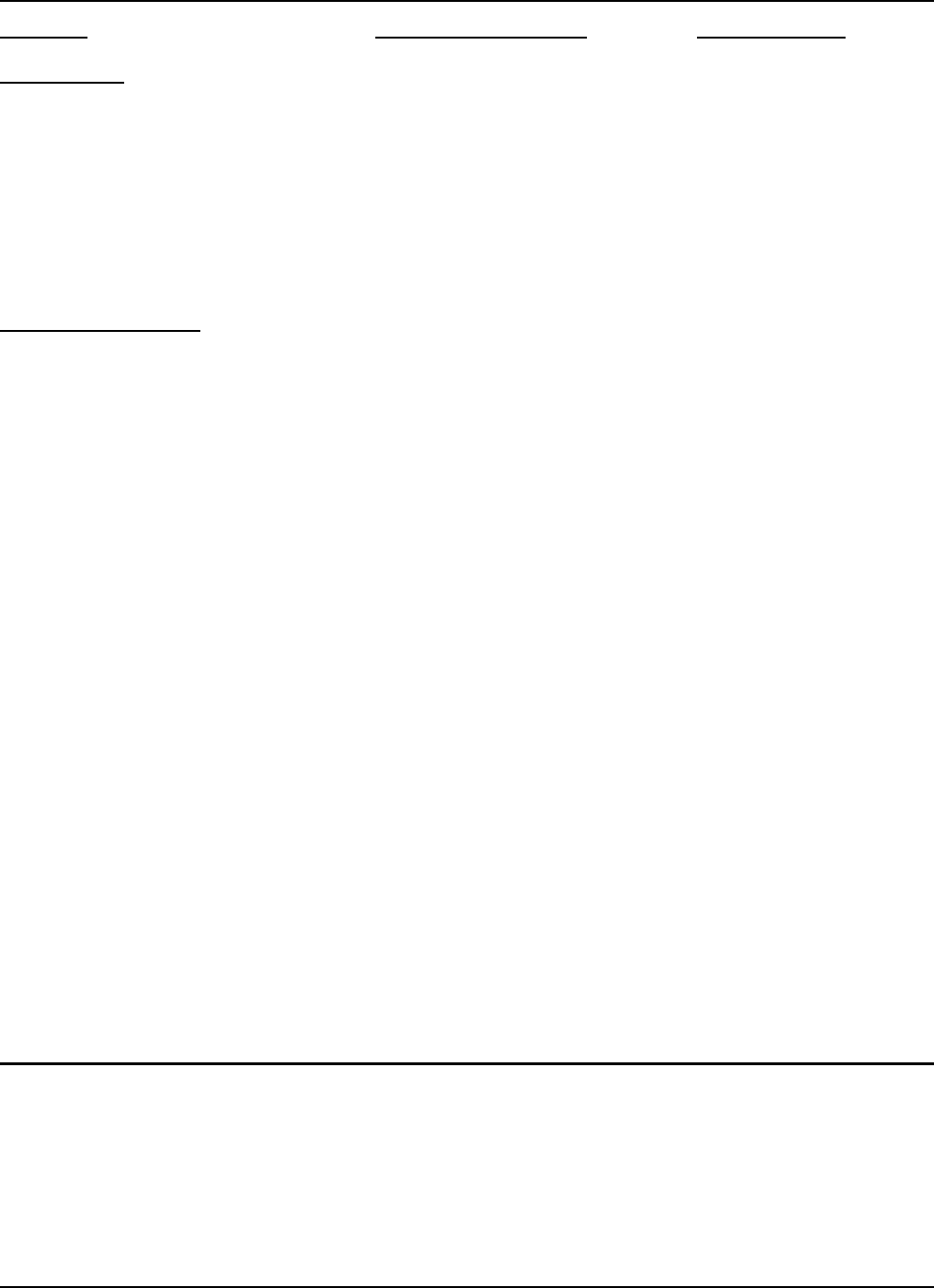
836A 2 kW UHF Translator, Internally Diplexed Remote Control Interface Connections
Function Remote Jack/Pin No. Interface Type
- Page 2 of 4 -
UHF Exciter - Continued
Remote Metering:
Reflected Power J10-5 1V full scale at 1kW
Reflected Power Rtn J10-17 source resistance
Exciter Output Power J10-10 1V full scale at 1kW
Exciter Output Power Rtn J10-22 source resistance
UHF Amplifier Trays
Remote Metering:
Forward Output Power (A6) UHF Amp J3-3 1V full scale at 1k
Forward Output Power (A6) Rtn J3-4 source resistance
Reflected O/P Power (A6) UHF Amp J3-5 1V full scale at 1k
Reflected O/P Power (A6) Rtn J3-6 source resistance
Forward Output Power (A7) UHF Amp J3-3 1V full scale at 1k
Forward Output Power (A7) Rtn J3-4 source resistance
Reflected O/P Power (A7) UHF Amp J3-5 1V full scale at 1k
Reflected O/P Power (A7) Rtn J3-6 source resistance
Forward Output Power (A8) UHF Amp J3-3 1V full scale at 1k
Forward Output Power (A8) Rtn J3-4 source resistance
Reflected O/P Power (A8) UHF Amp J3-5 1V full scale at 1k
Reflected O/P Power (A8) Rtn J3-6 source resistance
Forward Output Power (A9) UHF Amp J3-3 1V full scale at 1k
Forward Output Power (A9) Rtn J3-4 source resistance
Reflected O/P Power (A9) UHF Amp J3-5 1V full scale at 1k
Reflected O/P Power (A9) Rtn J3-6 source resistance
The above connections are made to Jack (J11), the 37 Position "D" Connector and to J10, the 25
Position "D" Connector, located on rear of the (A4) UHF Exciter or to Jack (J3), the 25 Position "D"
Connector, located on the rear of the (A6, A7, A8 & A9) UHF Amplifier Trays. Refer to the
Interconnect Drawing (1276-8000) for the proper Pin Remote Connections.
The Remote Connections are made, as listed below, if the Optional (A17) A/V Input & Remote
Interface Assembly (1276-1008) is present in your System. The Remote Connections are made to
Jacks J9 and J10 on the Assembly. Refer to the Interconnect Drawing (1276-8000) for the proper
Pin Remote Connections.
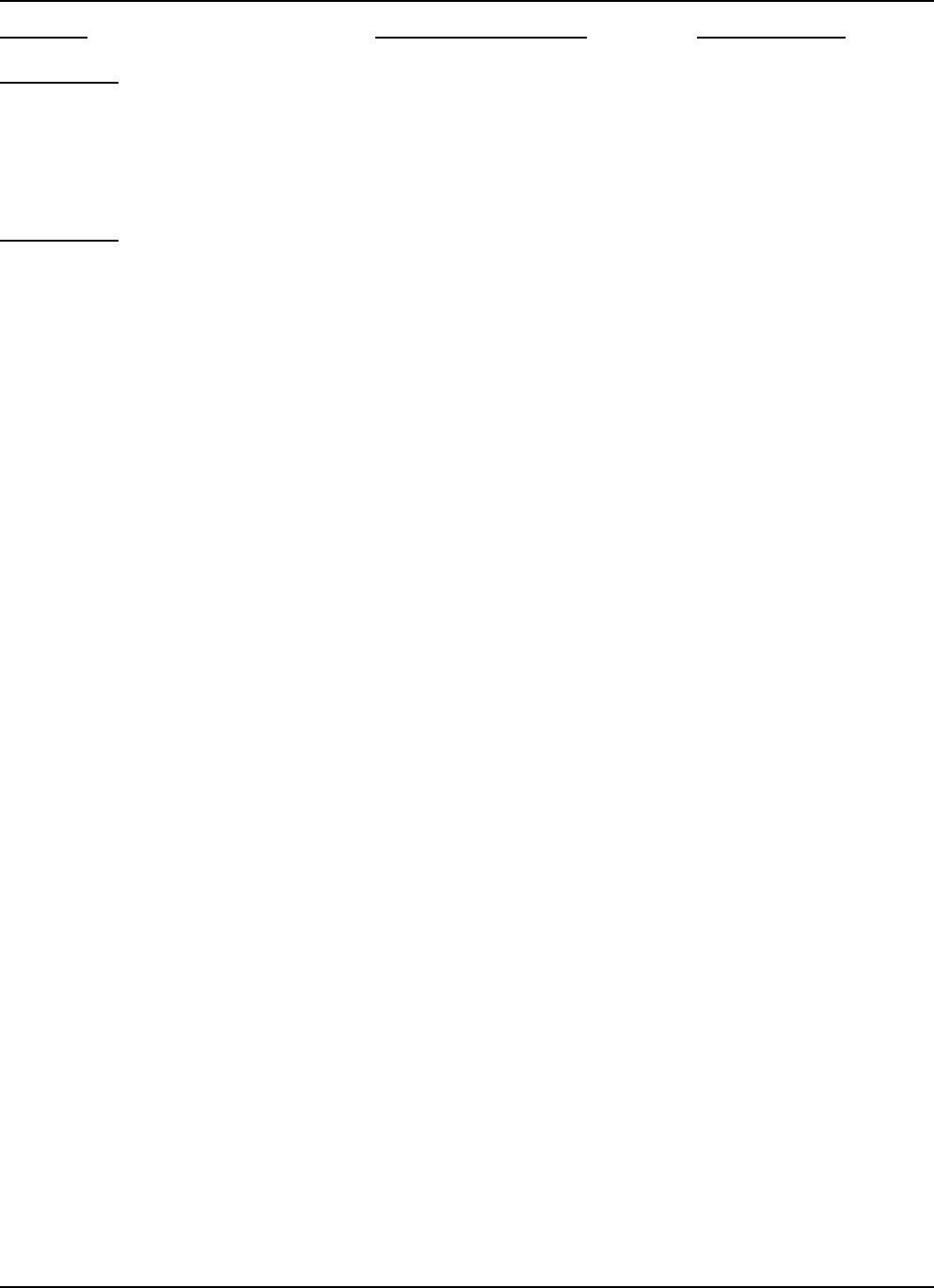
836A 2 kW UHF Translator, Internally Diplexed Remote Control Interface Connections
Function Remote Jack/Pin No. Interface Type
- Page 3 of 4 -
UHF Exciter
Translator Enable Interlock J9-21 J9-21 & 22 must be jumpered
Translator Enable Interlock Rtn.J9-22 together for Normal Operation.
(1176-1038) Jumper Jack is used.
UHF Exciter - Continued
Remote Control Commands:
Translator Standby (Disable) J9-9 Contact Closure
Translator Standby/Operate Rtn.J9-10
Translator Operate (Enable) J9-11 Contact Closure
Translator Manual J9-15 Contact Closure
Translator Auto/Manual Rtn.J9-16
Translator Auto J9-17 Contact Closure
Power Level Raise (Optional) J9-27 Contact Closure
Pwr Lvl Raise/Lower Rtn (Optional) J9-28
Power Level Lower (Optional) J9-29 Contact Closure
Modulator Select (Optional) J9-31 Contact Closure
Modulator Select Rtn (Optional) J9-32
Remote Status Indications:
Translator Operate (Enable) Ind. J9-12 50mA Max. Current Sink
Operate/Standby Ind. Return J9-13
Translator Standby (Disable) Ind. J9-14 50mA Max. Current Sink
Translator Auto Indicator J9-18 50mA Max. Current Sink
Auto/Manual Indicator Return J9-19
Translator Manual Indicator J9-20 50mA Max. Current Sink
VSWR Cutback Indicator J9-23 50mA Max. Current Sink
VSWR Cutback Indicator Return J9-24
Video Loss (Fault) Indicator J9-25 50mA Max. Current Sink
Video Loss (Fault) Ind. Rtn.J9-26
Receiver Fault Indicator J9-30 50mA Max. Current Sink
Remote Metering:
Visual Output Power J9-1 1V full scale at 1k
Visual Output Power Rtn J9-2 Source Resistance
Aural Output Power J9-3 1V full scale at 1k
Aural Output Power Rtn J9-4 Source Resistance
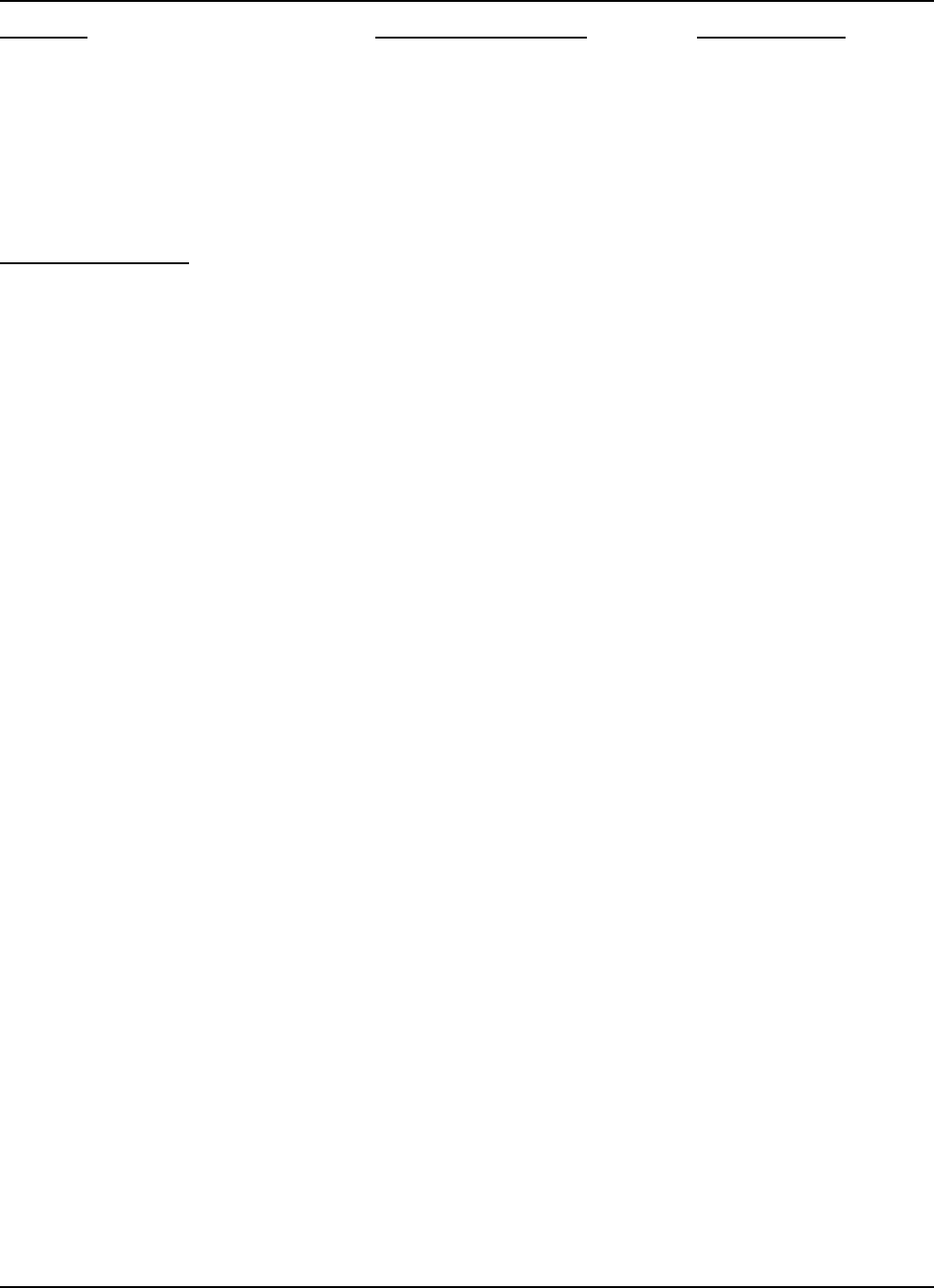
836A 2 kW UHF Translator, Internally Diplexed Remote Control Interface Connections
Function Remote Jack/Pin No. Interface Type
- Page 4 of 4 -
Reflected Power J9-5 1V full scale at 1k
Reflected Power Rtn J9-6 Source Resistance
Exciter Output Power J9-7 1V full scale at 1k
Exciter Output Power Rtn J9-8 Source Resistance
UHF Amplifier Tray
Remote Metering: - Continued
Forward Output Power (A6) UHF Amp J10-1 1V full scale at 1k
Forward Output Power (A6) Rtn J10-2 Source Resistance
Reflected O/P Power (A6) UHF Amp J10-3 1V full scale at 1k
Reflected O/P Power (A6) Rtn J10-4 Source Resistance
Forward Output Power (A7) UHF Amp J10-6 1V full scale at 1k
Forward Output Power (A7) Rtn J10-7 Source Resistance
Reflected O/P Power (A7) UHF Amp J10-8 1V full scale at 1k
Reflected O/P Power (A7) Rtn J10-9 Source Resistance
The Remote Connections as listed above are made to Jacks J9 and J10 on the A/V Input & Remote
Interface Assembly. Refer to the Interconnect Drawing (1276-8000) for the proper Pin Remote
Connections.

ITS-836A 2 kW UHF Translator, Internally Diplexed Drawing List (Subassemblies)
- Page 1 of 3 -
VHF L.O. Filter, High Band................................................................................... 1005-1208
Schematic .............................................................................................. 1005-3208
UHF Filter ........................................................................................................ 1007-1101
Schematic .............................................................................................. 1007-3101
VHF Channel Filter, Low Band .............................................................................. 1034-1202
Schematic .............................................................................................. 1034-3202
VHF L.O. Filter, Low Band ................................................................................... 1034-1211
Schematic .............................................................................................. 1034-3211
UHF Filter, DC Multiplexed, 50 Ohm....................................................................... 1035-1204
Schematic .............................................................................................. 1035-3204
(Optional) SAW Filter/Amplifier Board..................................................................... 1035-1211
Schematic .............................................................................................. 1035-3211
UHF Filter, 75/50 Ohm........................................................................................ 1035-1302
Schematic .............................................................................................. 1035-3302
UHF Amplifier Board, 50/75 Ohm........................................................................... 1035-1303
Schematic .............................................................................................. 1035-3303
VHF High Band Filter, DC Multiplexed, 50 Ohm......................................................... 1035-1601
Schematic .............................................................................................. 1035-3601
VHF High Band Filter, DC Multiplexed, Ohm ............................................................. 1035-1602
Schematic .............................................................................................. 1035-3602
VHF Amplifier Board, Low Noise, 50/75 Ohm............................................................ 1035-1701
Schematic .............................................................................................. 1035-3701
±12V(3A) Power Supply Board............................................................................. 1092-1206
Schematic .............................................................................................. 1092-3206
VHF High Band Channel Filter, 2 Section ................................................................ 1093-1202
Schematic .............................................................................................. 1093-3202
(Optional) IF Carrier Oven Oscillator Board, 38.9 MHz ............................................... 1100-1206
Schematic .............................................................................................. 1100-3206
(Optional) IF Filter/Limiter Board........................................................................... 1109-1001
Schematic .............................................................................................. 1109-3001
(Optional) IF PLL Board....................................................................................... 1109-1002
Schematic .............................................................................................. 1109-3002
Channel Oscillator Board, Dual Oven...................................................................... 1145-1201
Schematic .............................................................................................. 1145-3201
(Optional) VCXO Board, Dual Oven....................................................................... 1145-1204
Schematic .............................................................................................. 1145-3204
(Optional) IF Amplifier Board, High Gain................................................................. 1197-1126
Schematic .............................................................................................. 1197-3126

ITS-836A 2 kW UHF Translator, Internally Diplexed Drawing List (Subassemblies)
- Page 2 of 3 -
x8 Multiplier Board ............................................................................................. 1227-1002
Schematic .............................................................................................. 1227-3002
IF Phase Corrector Board.................................................................................... 1227-1250
Schematic .............................................................................................. 1227-3250
1 Watt Amplifier Board........................................................................................ 1227-1303
Schematic .............................................................................................. 1227-3303
4 Way Splitter Board.......................................................................................... 1227-1312
Schematic .............................................................................................. 1227-3312
Coupler Board Assembly...................................................................................... 1227-1316
Schematic .............................................................................................. 1227-3316
Dual Peak Detector Board, Single Supply................................................................ 1227-1333
Schematic .............................................................................................. 1227-3333
Downconverter Amplifier Board............................................................................. 1227-1502
Schematic .............................................................................................. 1227-3502
Dual Stage Amplifier Assembly.............................................................................. 1227-1503
Schematic .............................................................................................. 1227-3501
IF Filter/ALC Board ............................................................................................ 1227-1504
Schematic .............................................................................................. 1227-3504
x2 Multiplier Board ............................................................................................. 1227-1524
Schematic .............................................................................................. 1227-3524
x4 Multiplier Board ............................................................................................. 1227-1525
Schematic .............................................................................................. 1227-3525
UHF Amplifier Board, Low Noise ............................................................................ 1257-1101
Schematic .............................................................................................. 1257-3101
UHF Variable Gain Amplifier Board.......................................................................... 1265-1126
Schematic .............................................................................................. 1265-3126
VHF Variable Gain Amplifier Board.......................................................................... 1265-1127
Schematic .............................................................................................. 1265-3127
ALC Board........................................................................................................ 1265-1305
Schematic .............................................................................................. 1265-3305
(Optional) EEPROM FSK Identifier Board ................................................................. 1265-1308
Schematic .............................................................................................. 1265-3308
Visual/Aural Metering Board................................................................................. 1265-1309
Schematic .............................................................................................. 1265-3309
UHF Upconverter Board ...................................................................................... 1265-1310
Schematic .............................................................................................. 1265-3310

ITS-836A 2 kW UHF Translator, Internally Diplexed Drawing List (Subassemblies)
- Page 3 of 3 -
Transmitter Control Board ................................................................................... 1265-1311
Schematic .............................................................................................. 1265-3311
+12V(4A)/-12V(1A) Power Supply Board................................................................ 1265-1312
Schematic .............................................................................................. 1265-3312
Dual Stage Amplifier Assembly, Mid Band, Class AB................................................... 1265-1411
Is made from a Generic Dual Stage Amplifier Board, Class AB (1265-1404).
Schematic .............................................................................................. 1265-3411
Amplifier Protection Board ................................................................................... 1265-1412
Schematic .............................................................................................. 1265-3412
Dual Stage Amplifier Assembly, Low Band, Class AB.................................................. 1265-1413
Is made from a Generic Dual Stage Amplifier Board, Class AB (1265-1404).
Schematic .............................................................................................. 1265-3413
Amplifier Control Board ....................................................................................... 1265-1414
Schematic .............................................................................................. 1265-3414
Single Stage Amplifier Assembly, Mid Band, Class A.................................................. 1265-1416
Is made from a Generic Single Stage Amplifier Board, Class A (1265-1415).
Schematic .............................................................................................. 1265-3416
Single Stage Amplifier Assembly, High Band, Class A................................................. 1265-1417
Is made from a Generic Single Stage Amplifier Board, Class A (1265-1415).
Schematic .............................................................................................. 1265-3417
Single Stage Amplifier Assembly, Low Band, Class A ................................................. 1265-1418
Is made from a Generic Single Stage Amplifier Board, Class A (1265-1415).
Schematic .............................................................................................. 1265-3418
Dual Stage Amplifier Assembly, High Band, Class AB ................................................. 1265-1420
Is made from a Generic Dual Stage Amplifier Board, Class AB (1265-1404).
Schematic .............................................................................................. 1265-3420
Variable Gain/Phase Board................................................................................... 1265-1425
Schematic .............................................................................................. 1265-3425
Dual Stage Amplifier Assembly, Low Band, Class AB.................................................. 1265-1439
Is made from a Generic Dual Stage Amplifier Board, Class AB (1265-1404).
Schematic .............................................................................................. 1265-3439
Dual Stage Amplifier Assembly, Mid Band, Class AB................................................... 1265-1440
Is made from a Generic Dual Stage Amplifier Board, Class AB (1265-1404).
Schematic .............................................................................................. 1265-3440
Dual Stage Amplifier Assembly, High Band, Class AB ................................................. 1265-1441
Is made from a Generic Dual Stage Amplifier Board, Class AB (1265-1404).
Schematic .............................................................................................. 1265-3441

836A 2 kW UHF Translator, Internally Diplexed Maintenance
- Page 1 of 1 -
The 836A is designed with components that require little or no periodic maintenance except for the
routine cleaning of the Fans and front panels of the Trays.
The amount and time interval between cleanings depends on the conditions within the Transmitter
room. While the electronics have been designed to function even if covered with dust. A heavy
buildup of dust, dirt or insects will hinder the effectiveness of the cooling of the components and
lead to a thermal shutdown or premature failure of the affected Tray.
When the front panels become dust covered, the top covers should be removed and any
accumulated foreign material removed. A vacuum cleaner utilizing a small wand type attachment is
an excellent way to suction out the dirt. Alcohol and other cleaning agents should not be used
unless you are certain that the solvents will not damage components or the silk-screened markings
on the Trays and boards. Water based cleaners can be used, but do not saturate the
components. The fans and heatsinks should be cleaned of all dust or dirt to permit the free flow of
air for cooling purposes.
It is recommended that the operating parameters of the Translator be recorded from the meters on
the Exciter and the Amplifier Trays at least once a month. It is suggested that the data be
retained in a rugged folder or envelope for the life of the equipment. A sample format for a Log
Sheet is included in this section. Photocopies of the Log Sheet should be made for continued data
entries.

836A 2 kW UHF Translator, Internally Diplexed Log Report Sheet
- Page 1 of 1 -
UHF Exciter
% Aural Power (0 - 100) = _____________% % Visual Power (0 - 100) =
____________%
% Reflected (0 - 100) = _____________% % Exciter (0 - 100) = ______________%
ALC (0 - 1 V) = _________________V
UHF Amplifier Trays
(A6) (A7)
AGC Voltage = _________V AGC Voltage = _________V
% Reflected = _________% % Reflected = _________%
% Output Forward = _________% % Output Forward = _________%
Power Supply = __________V Power Supply = __________V
(A8) (A9)
AGC Voltage = _________V AGC Voltage = _________V
% Reflected = _________% % Reflected = _________%
% Output Forward = _________% % Output Forward = _________%
Power Supply = __________V Power Supply = __________V
Date __________________
Customer Name _____________________________________ Call Letters ________________
Technician ___________________________________________
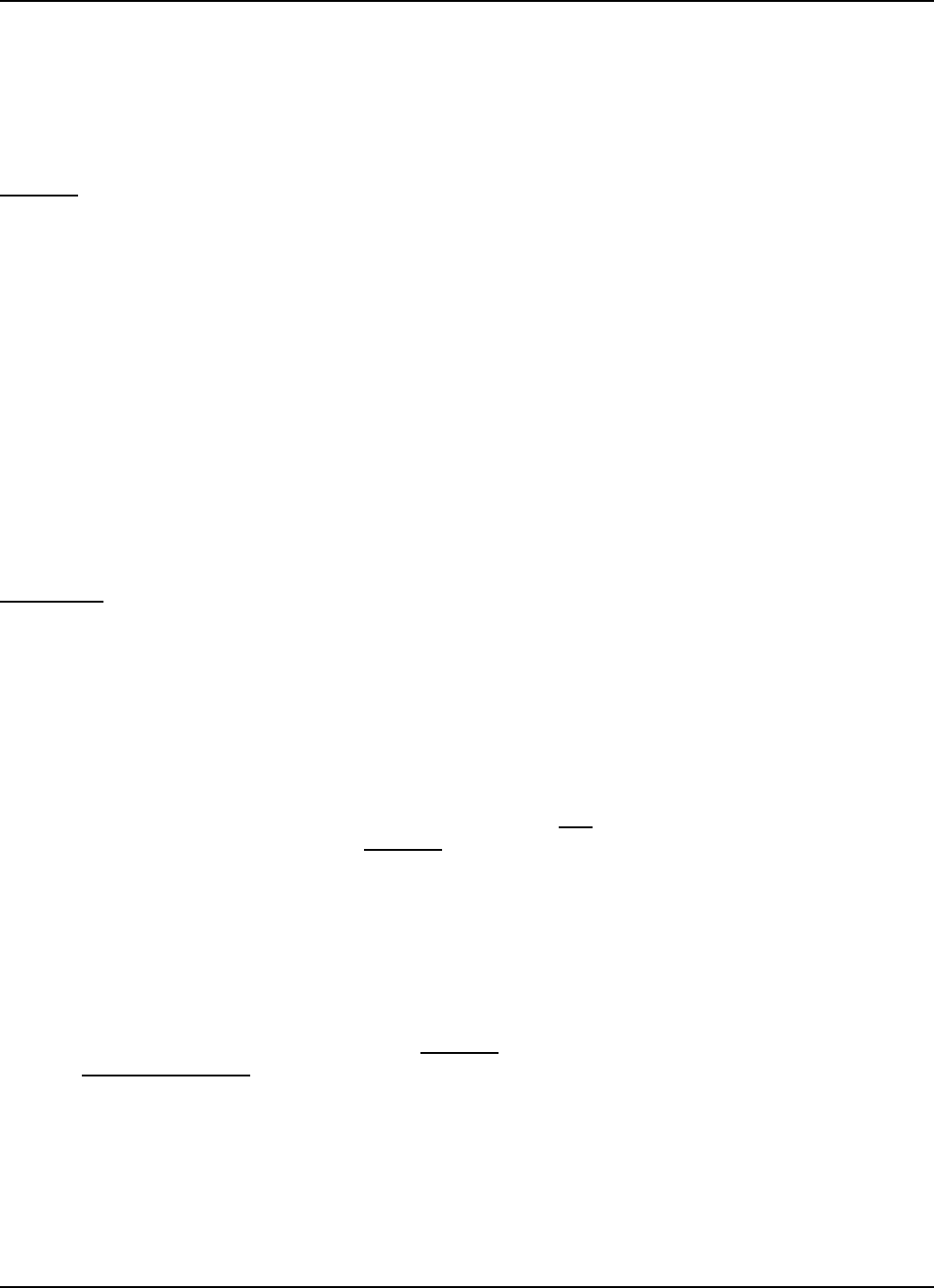
Maintenance Bulletin Topic: Flanged RF Amplifier Transistors
- Page 1 of 2 -
This Bulletin covers the procedure for the replacement of Flanged RF Amplifier Transistors. These
transistors, both Bipolar and FET types, are mounted directly to heat sink assemblies using two
mounting screws. This category of transistor covers a number of different types and part
numbers, but the information covered in this bulletin is of a general nature and applies to all such
transistors.
Caution:Some of the transistors may contain beryllium oxide, a toxic material. If a device
becomes damaged and the inner material is exposed do not handle the transistor.
If a Flanged Transistor needs replaced due to failure of the component, the following procedure
should be completed during the installation and initial operation of the new component.
1. Remove the voltages to the device that you are about to change. This is accomplished by
turning the Transmitter Off, by removing the power plug located on the Opto Bias Board to
that device or by removing the fuse located on the Amplifier Protection Board, Dual Bias
Protection Board or the Fused Current Metering Board associated with the Transistor Device.
2. Remove the two machine screws that mount the transistor to the heat sink assembly.
3. Using a soldering iron and solder wick, remove the solder from the tabs of the transistor which
are soldered to the board. Lift the tabs from the board and carefully remove the transistor
from the assembly. Be careful not to peal the track off the PC Board. If there are chip style
capacitors soldered to the tabs, they need to be replaced along with the transistor.
Important:Note the position of any chip capacitors which are soldered to the tabs of the
transistor and before completely removing the transistor from its mounting place,
note how the transistor is mounted on the board, so that the new transistor is
mounted properly.
4. Check that the heat sink surface on which the transistor was mounted is free from any debris
and is smooth. If the surface is irregular, a piece of 440 sand paper or emery cloth can be
used to smooth it. Irregularities in this surface cause poor heat transfer from the transistor to
the heat sink.
5. Remove the new transistor from the case, and apply a thin coat of heat sink compound to the
bottom surface of the transistor. Caution: Only a thin coat of heat sink compound is needed;
too much will cause poor heat transfer. Place the new transistor into the area from which the
old device was removed. Using the machine screws that were removed in Step 2, mount the
new device in place, by first lightly tightening one side then the other. Repeat the process
until both sides of the transistor are equally tight.
6. Solder the Base and Collector or Drain and Source Tabs to the board, as the previous
transistor was soldered. Check that a good solder flow is achieved and that no solder is
shorted to other tracks. Solder new Chip Capacitors, of the same value as removed, in the
same locations as they were originally. Caution: Use a temperature controlled soldering iron
and Do Not Overheat the Chip Capacitors as they are soldered in place.
7. Before applying power to the device, the Operating Current of the device must be turned
down. This is accomplished by turning the Bias Adjustment Potentiometer located on the Opto
Bias Board, GaAs FET Control Board or in the Drain Circuit of the FET Device to the full
Counter-Clockwise position.
8. The Idling or Static Current of the Device is initially set with no RF Drive applied to the Device.
Remove the RF Drive Signal input to the Device or Module. Start the Set up of the Idling
Current by first restoring the Supply Voltage to the Transistor by reversing the process used in
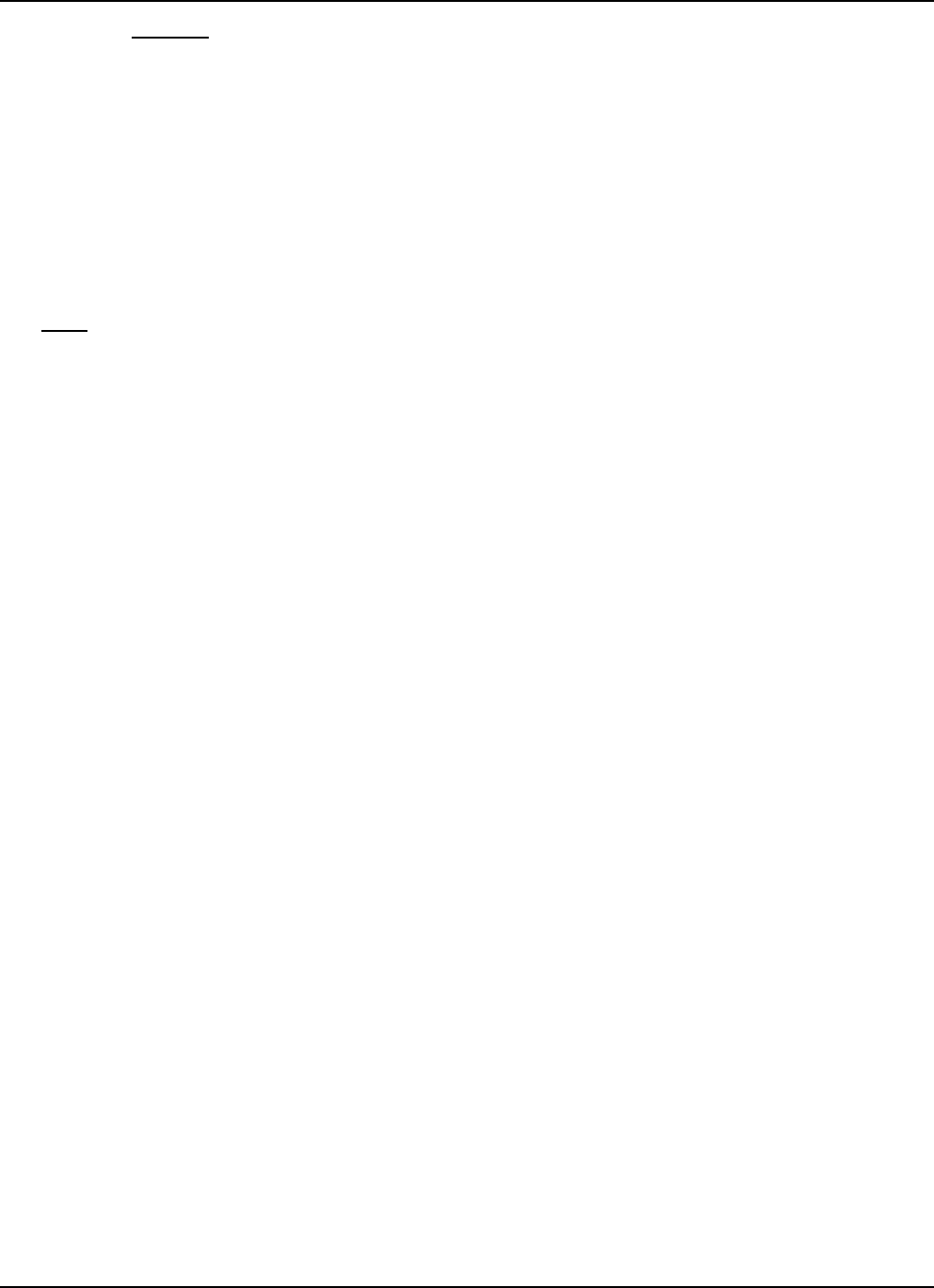
Maintenance Bulletin Topic: Flanged RF Amplifier Transistors
- Page 2 of 2 -
Step 1. Caution: If the device being replaced is a GaAs FET, before applying the Positive
Voltage to the Device check that the Negative Bias Voltage is applied to the Device.
9. The amount of Static Collector or Drain Current is calculated using Ohm's Law (I = E\R).
Measure the voltage drop across the Collector or Drain Resistor, one lead on each side of the
Resistor. In amplifiers using Bipolar Transistors, the Resistor is located on the Amplifier Board
in the Collector Circuit of the Transistor near where the Supply Voltage enters the Board. In
amplifiers that have GaAs FETs the Resistor is located on the GaAs FET Control Board or on
the Amplifier Board in the Drain Circuit. Adjust the Bias Adjustment Pot located in the Gate
Circuit until the desired voltage drop is measured across the .1 ohm resistor. See the Detailed
Alignment Procedure for the Tray in which the Amplifier Board is located to find the amount of
Collector or Drain Current and the necessary Voltage Drop needed to attain it.
Note:See the Detailed Alignment Procedure for the Tray in which the amplifier board is
located to find the amount of collector or drain current and the necessary voltage
drop needed to attain it.
10. Reapply the RF Drive to the Module and you are ready for normal operation.